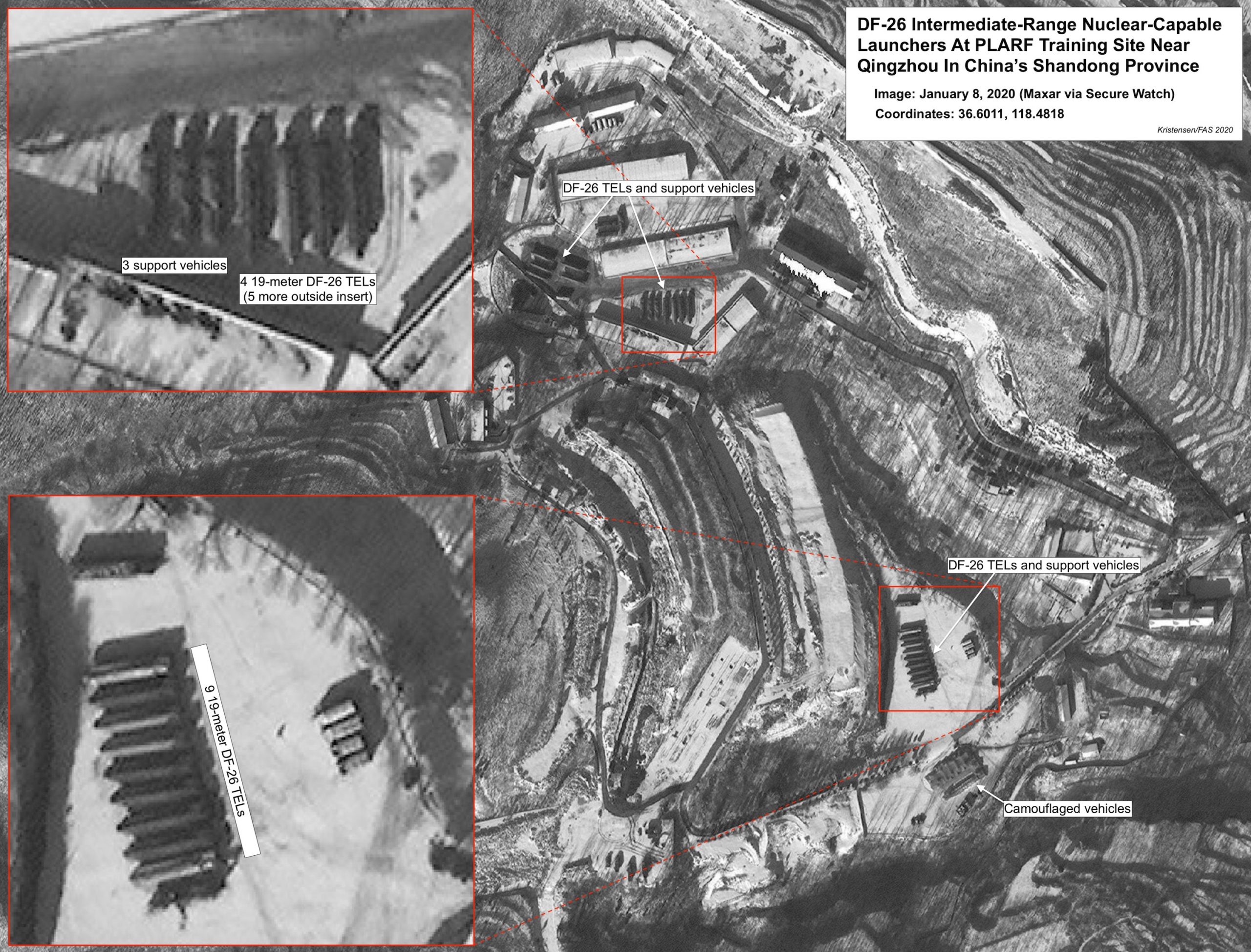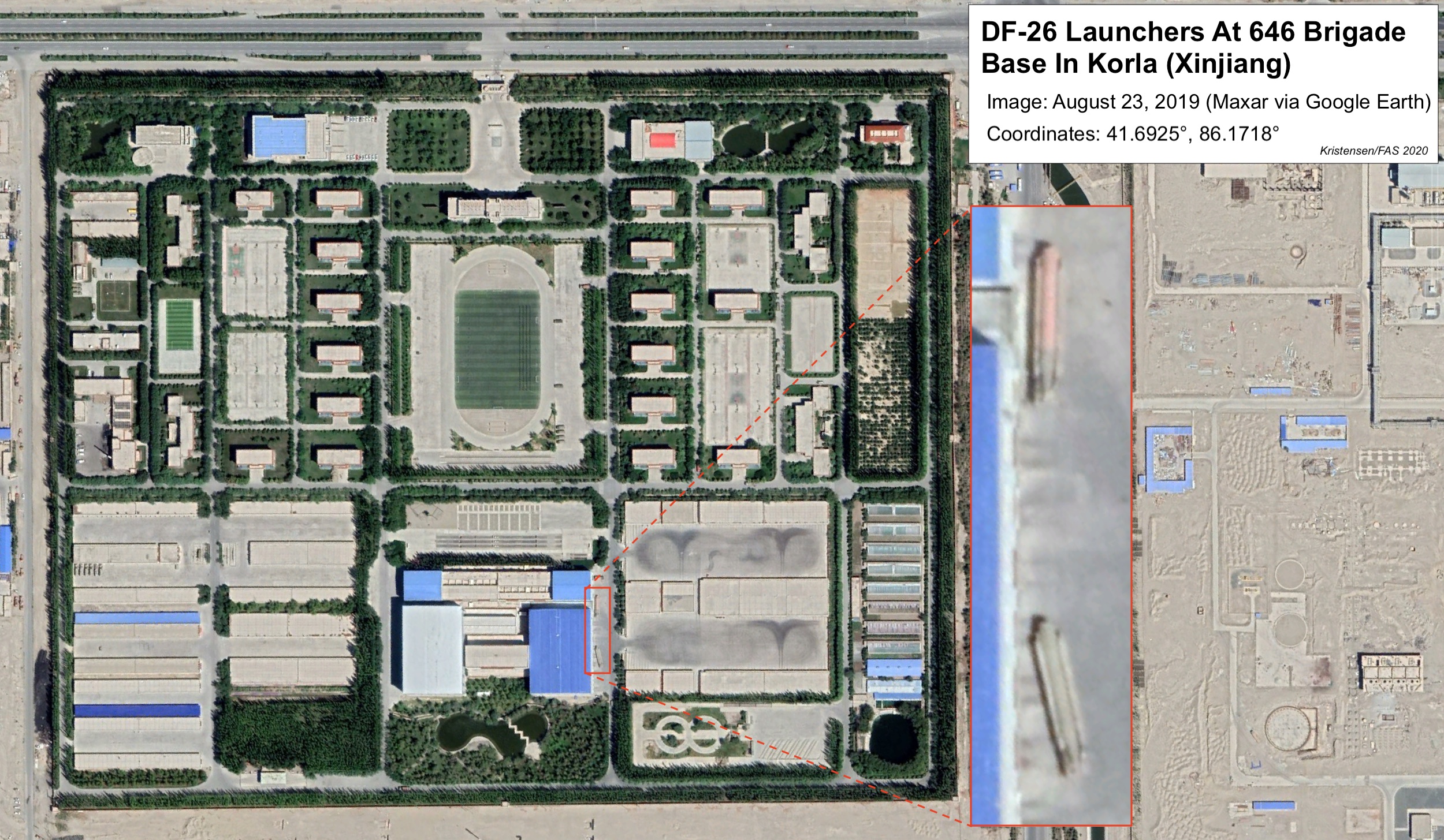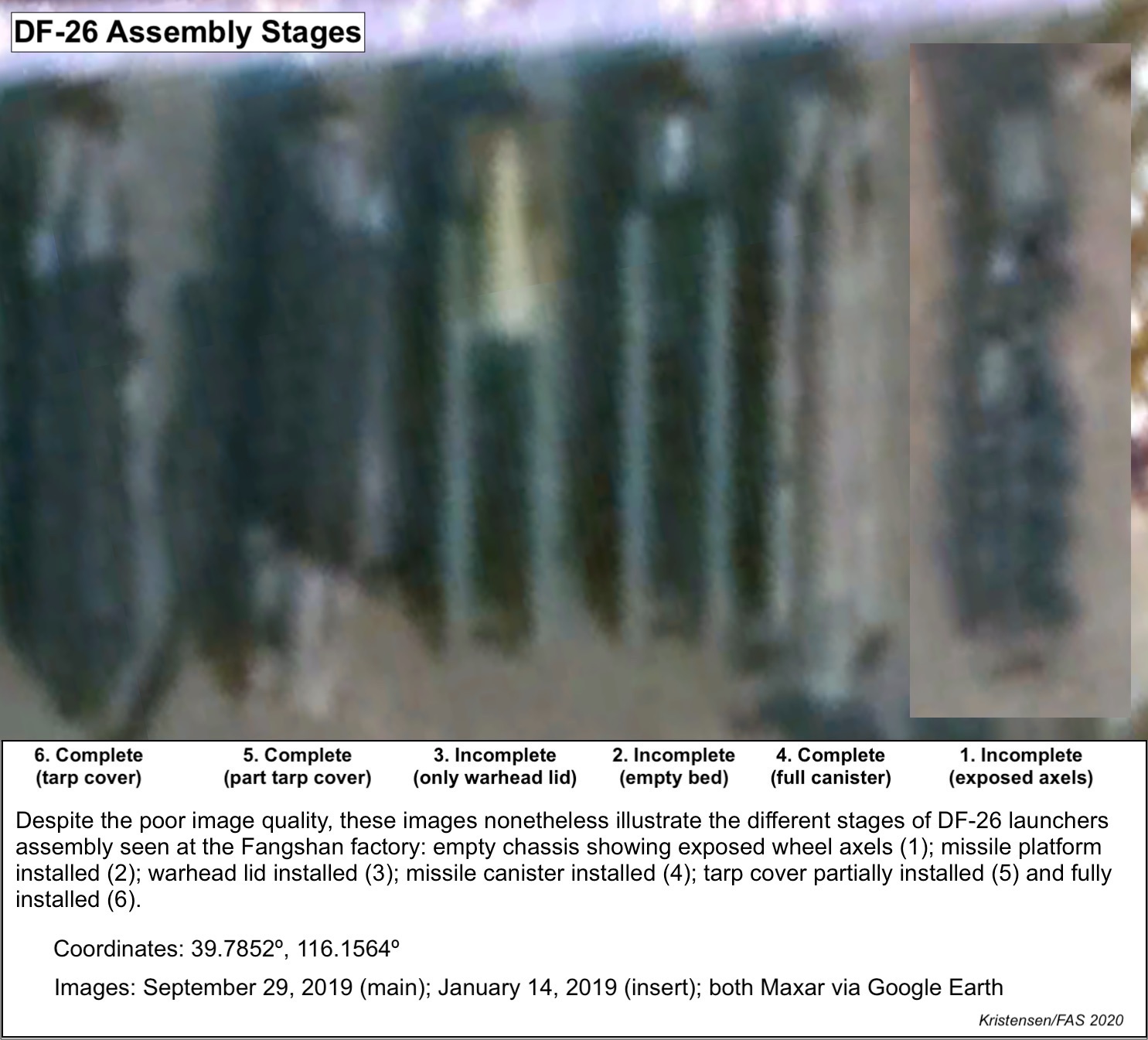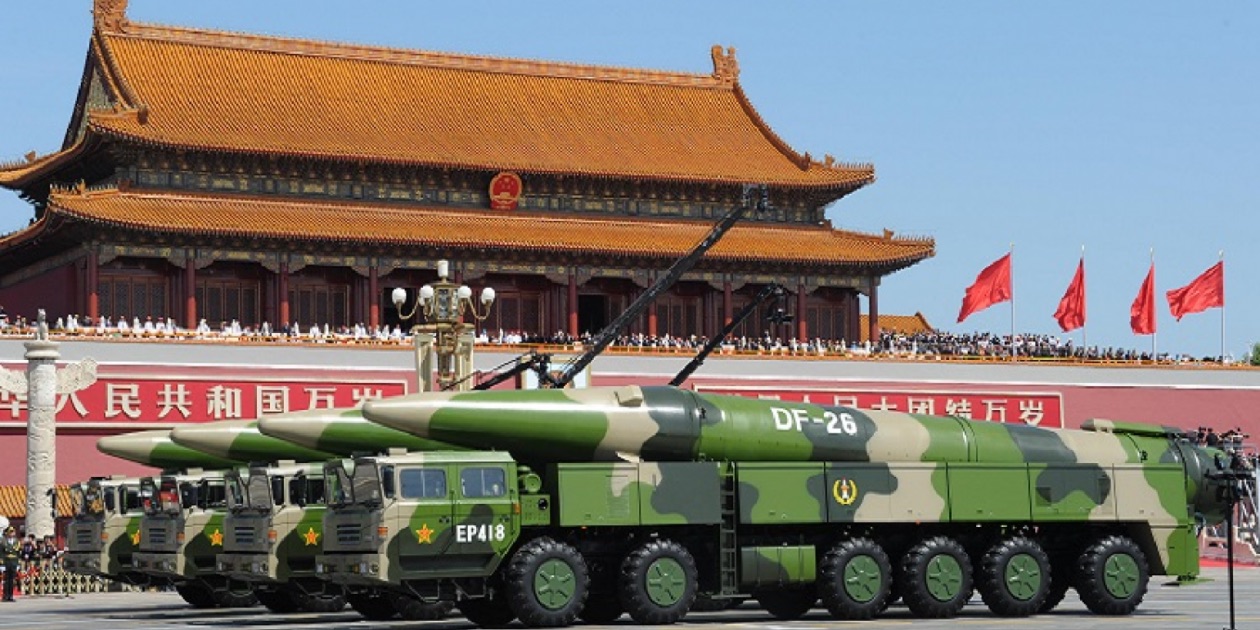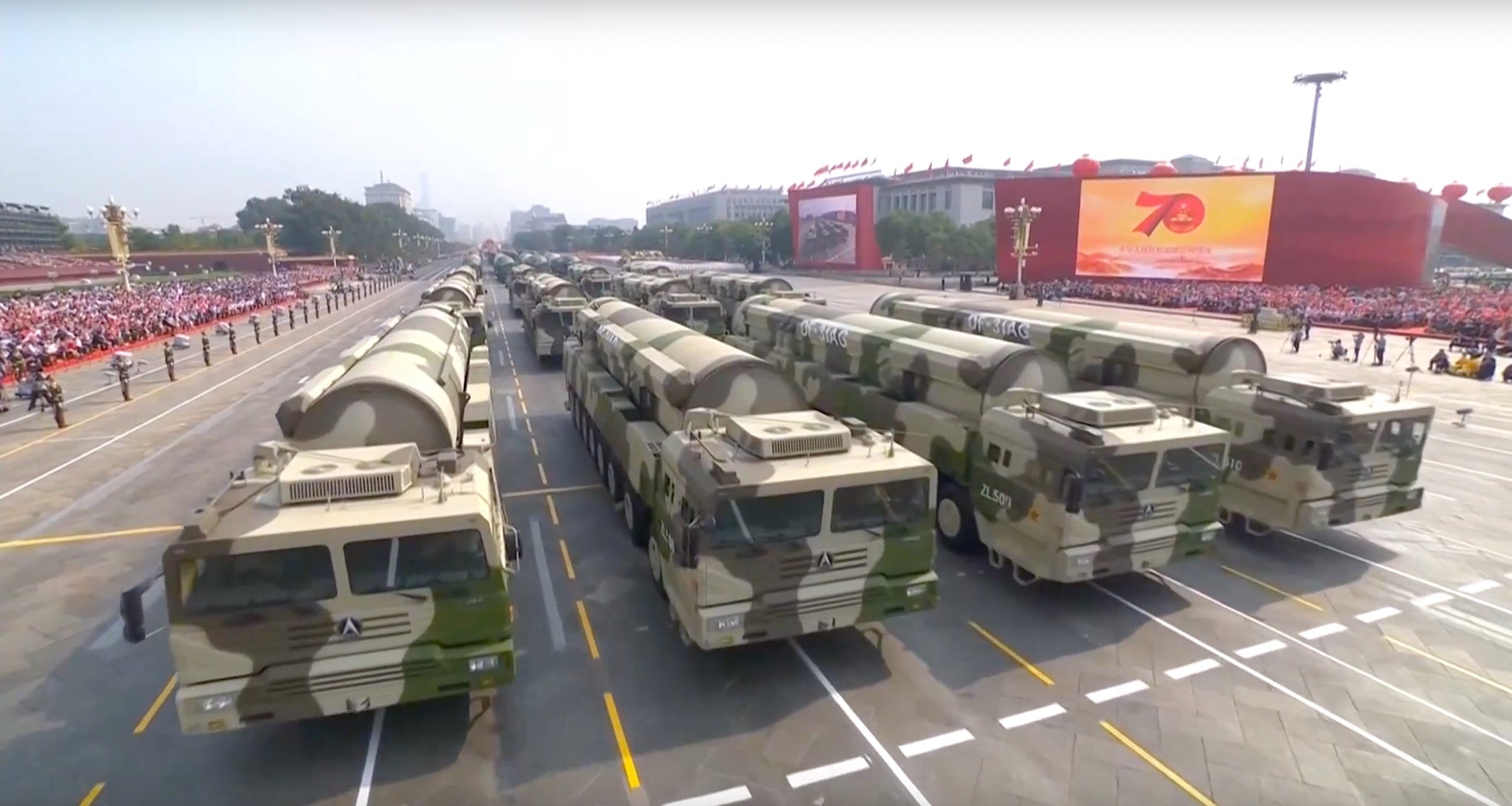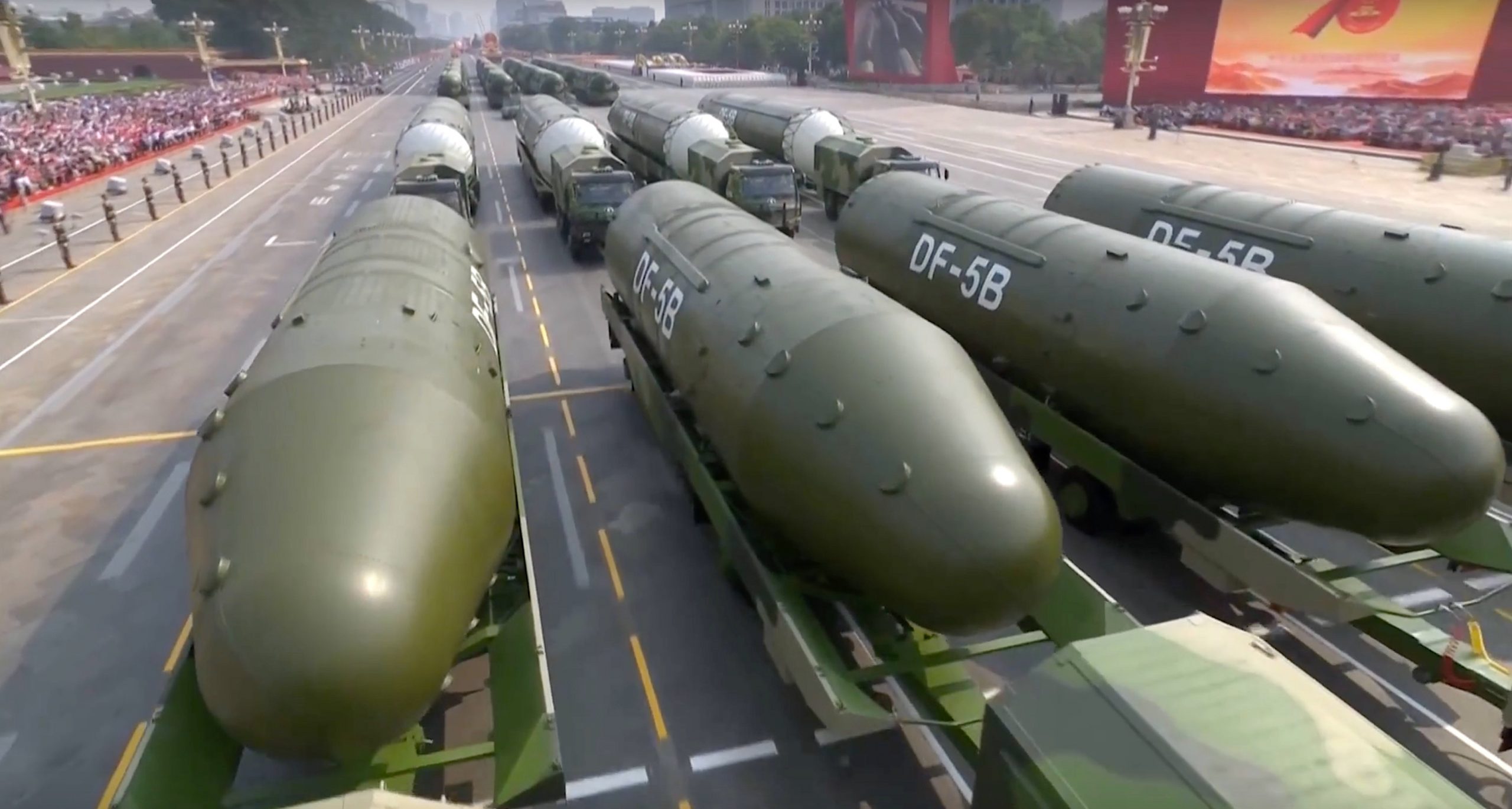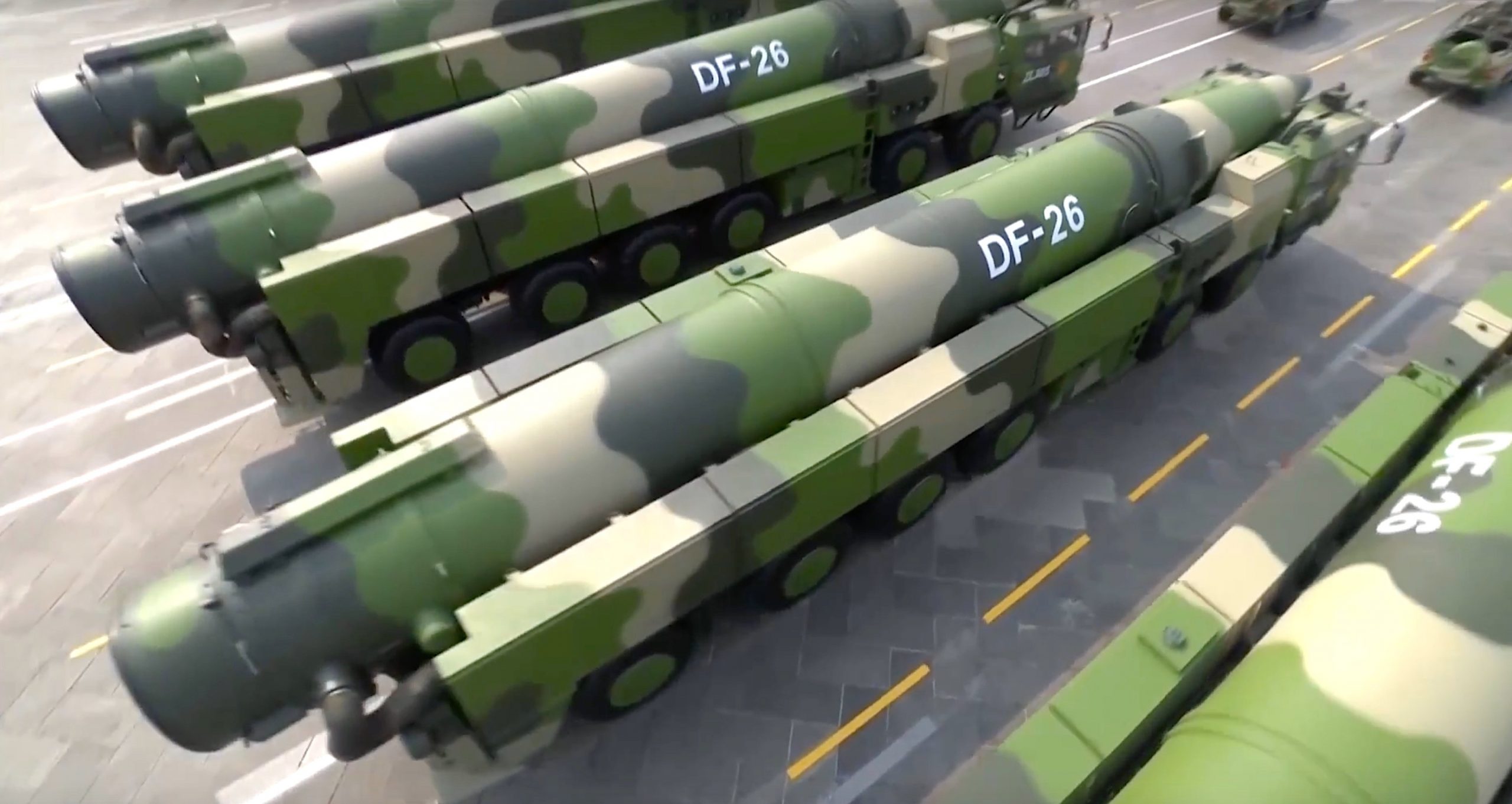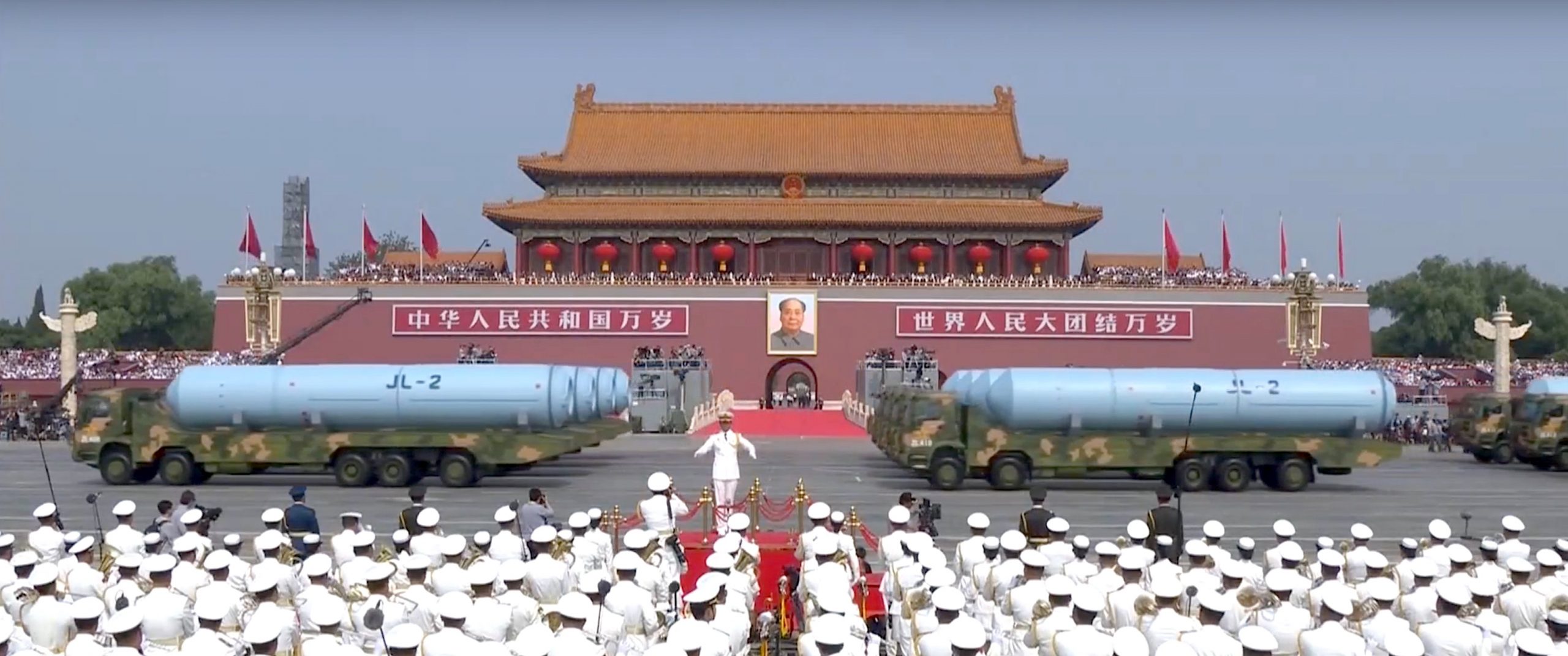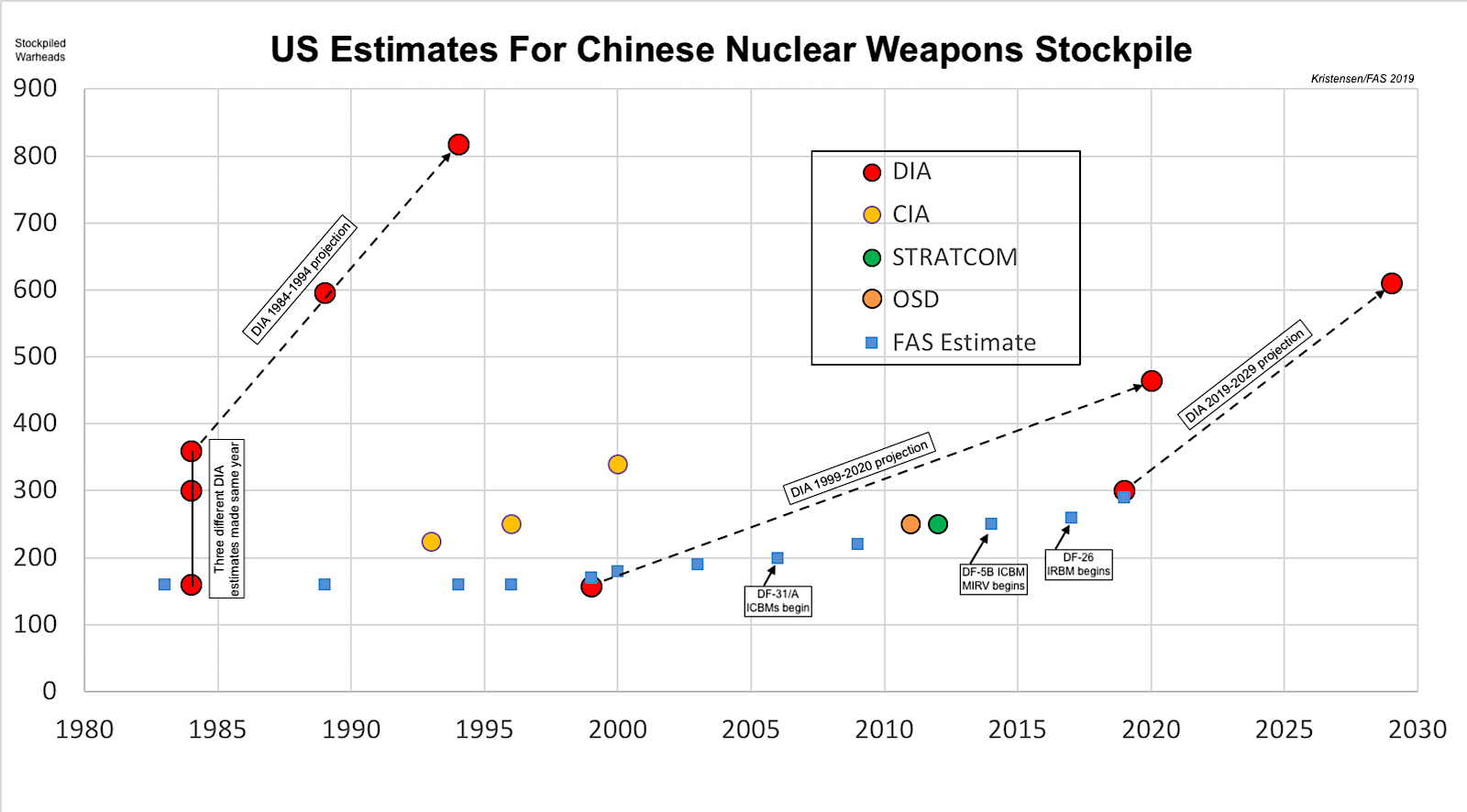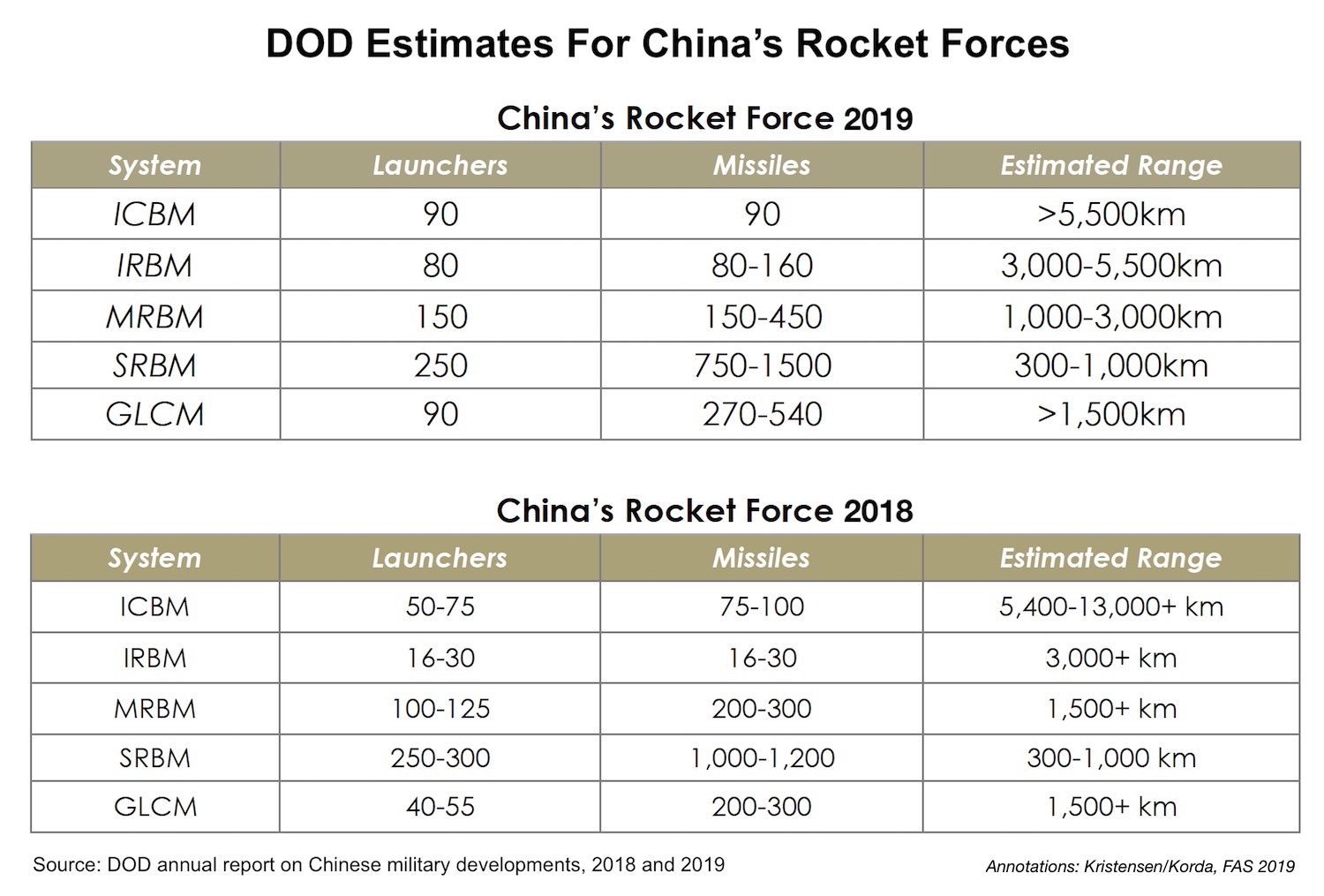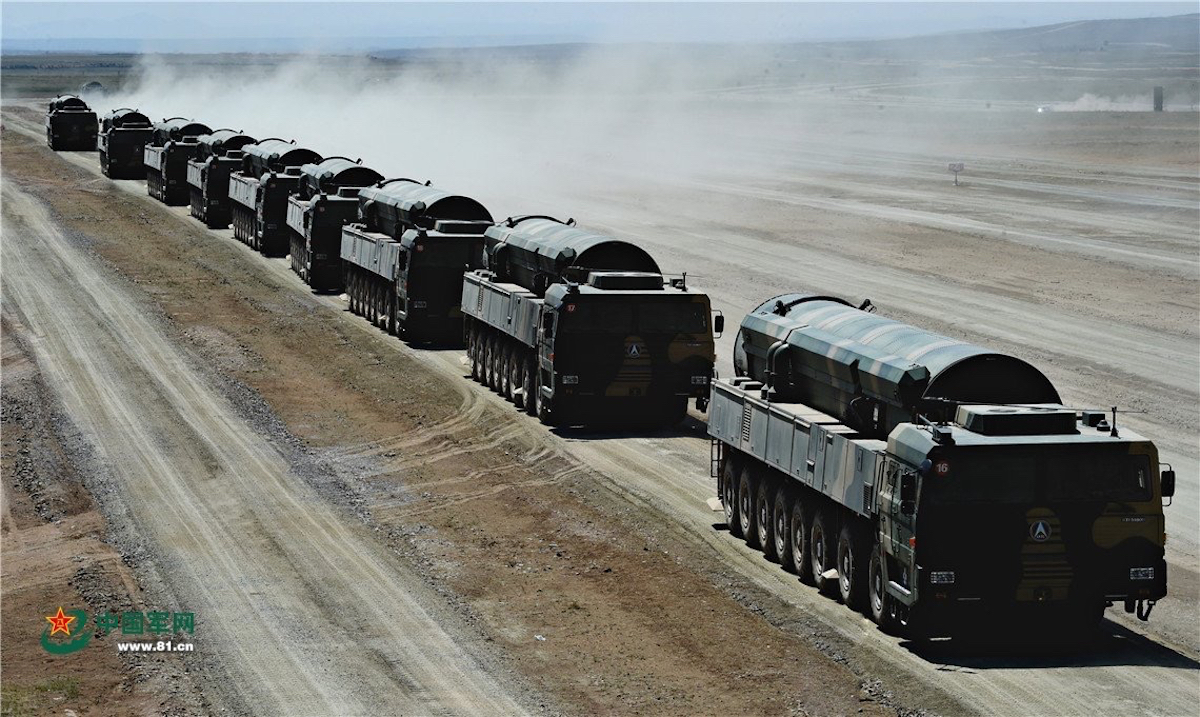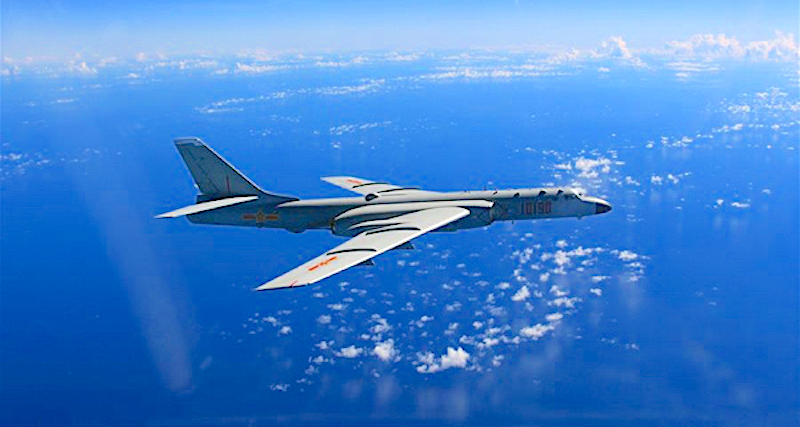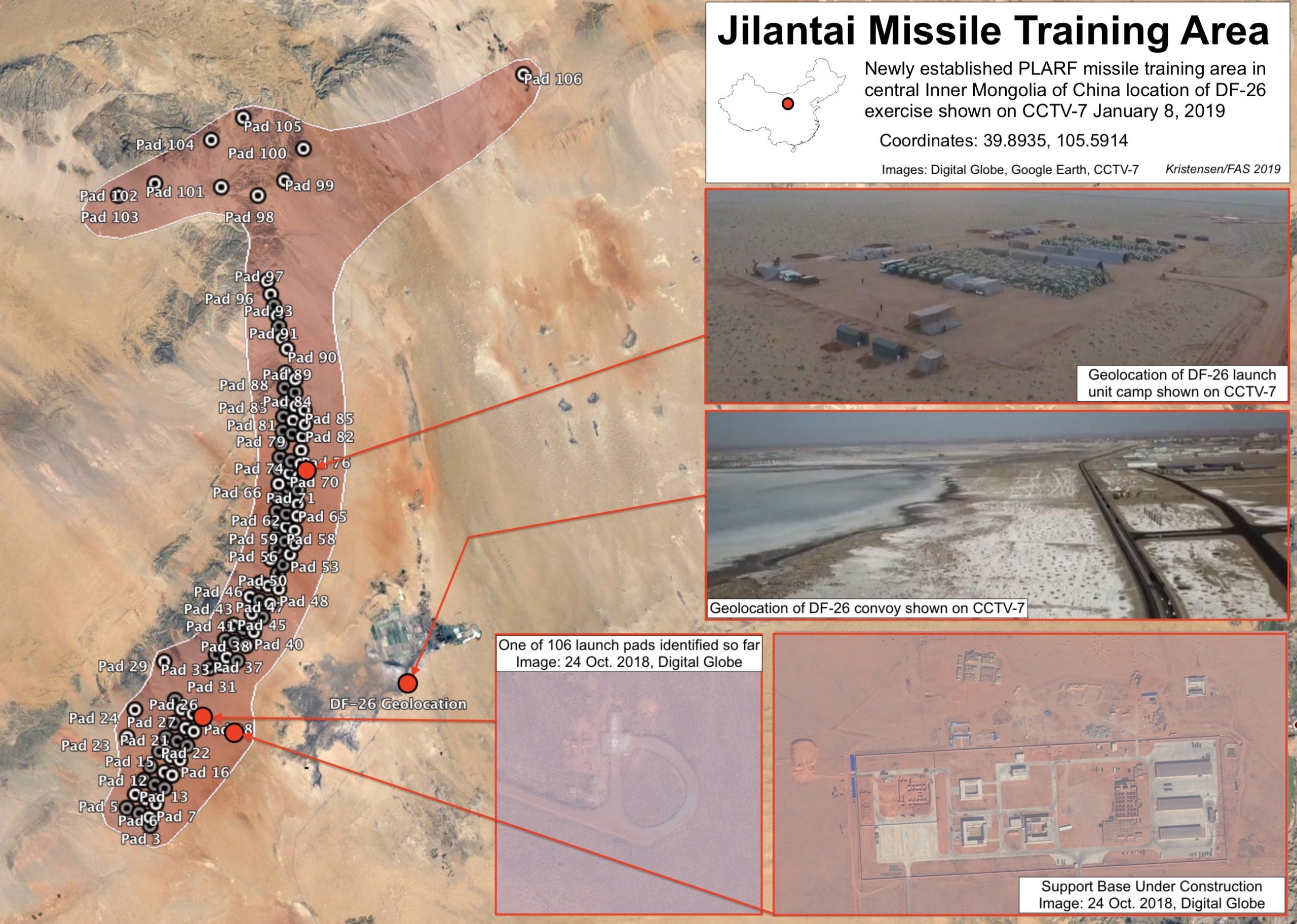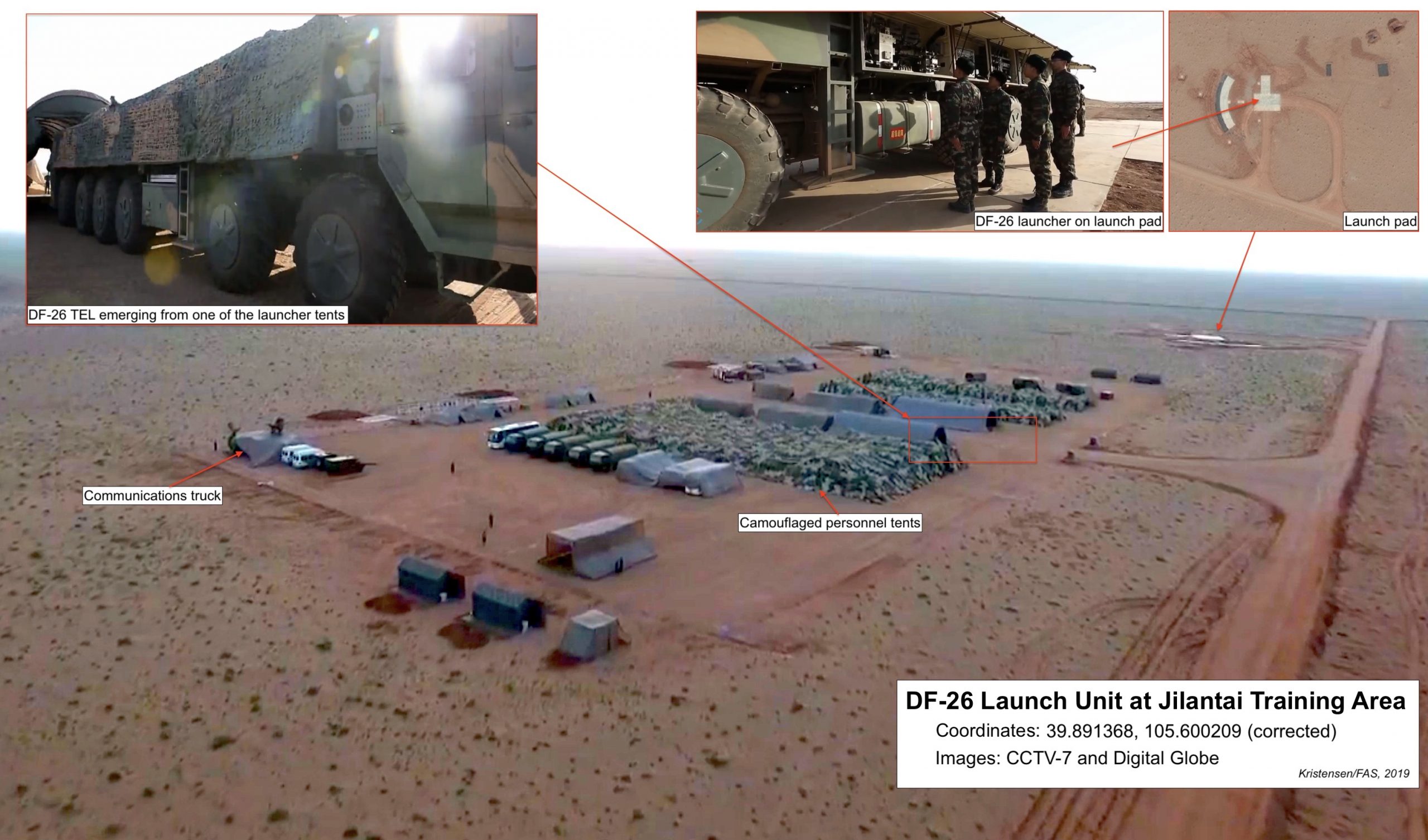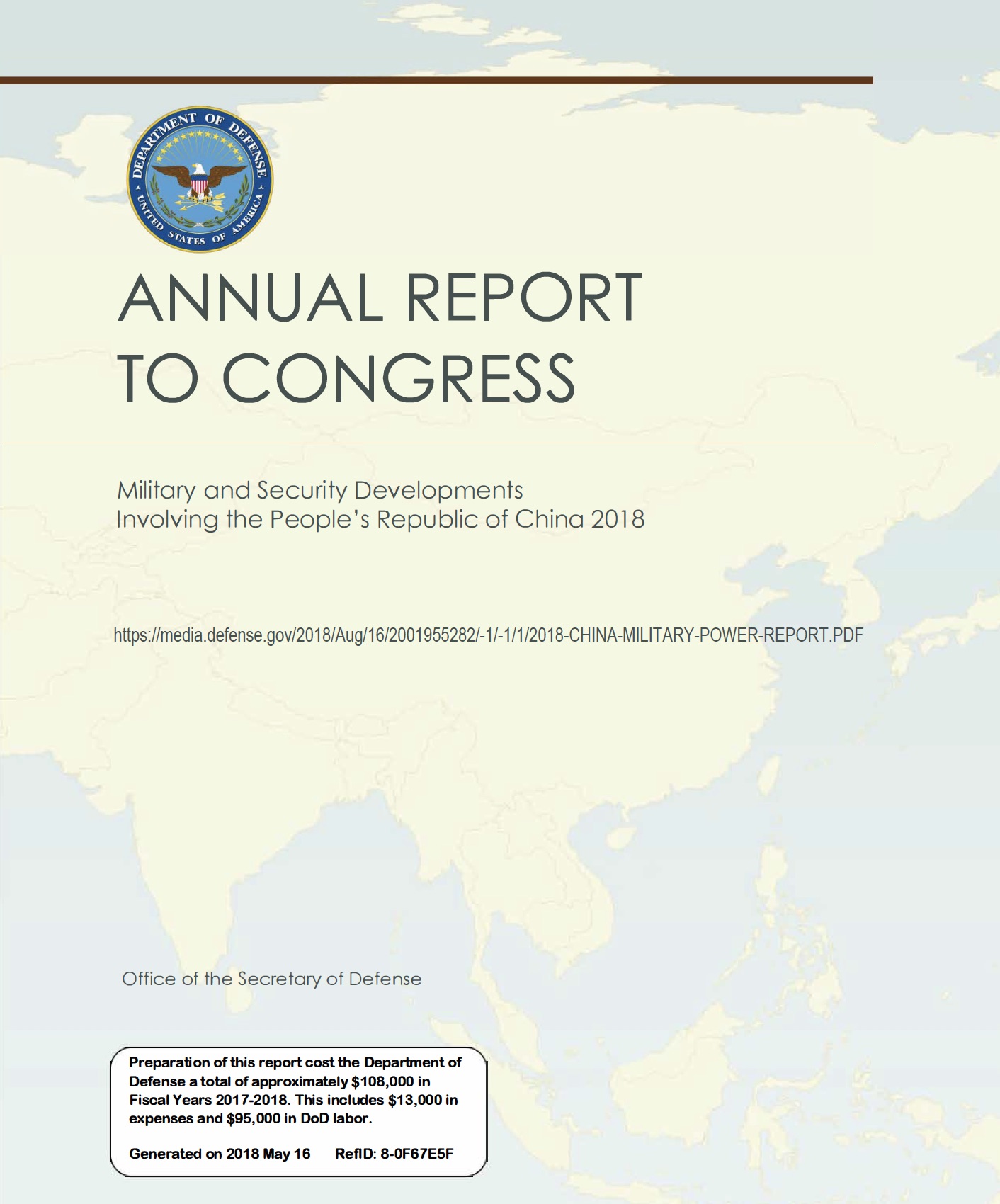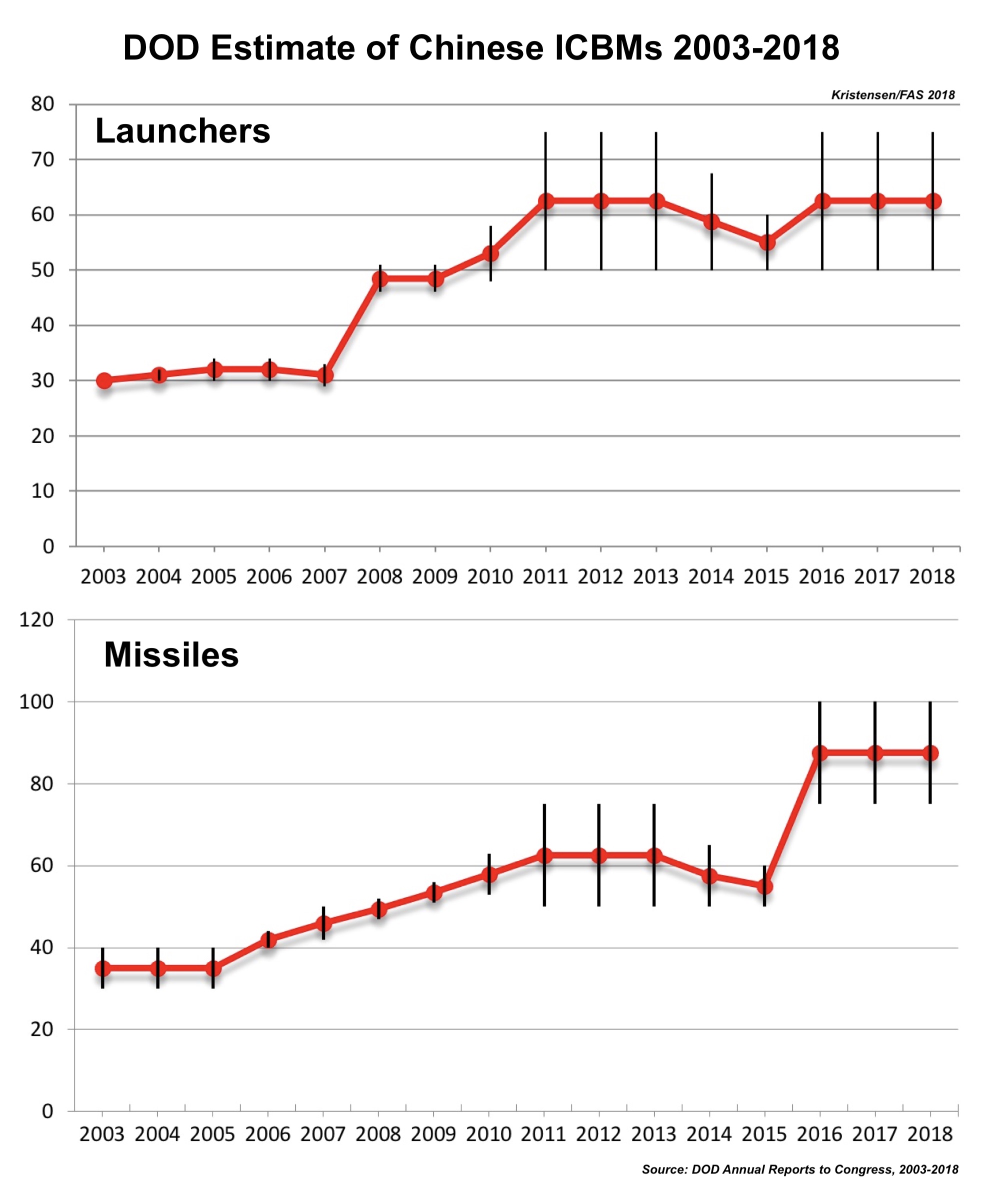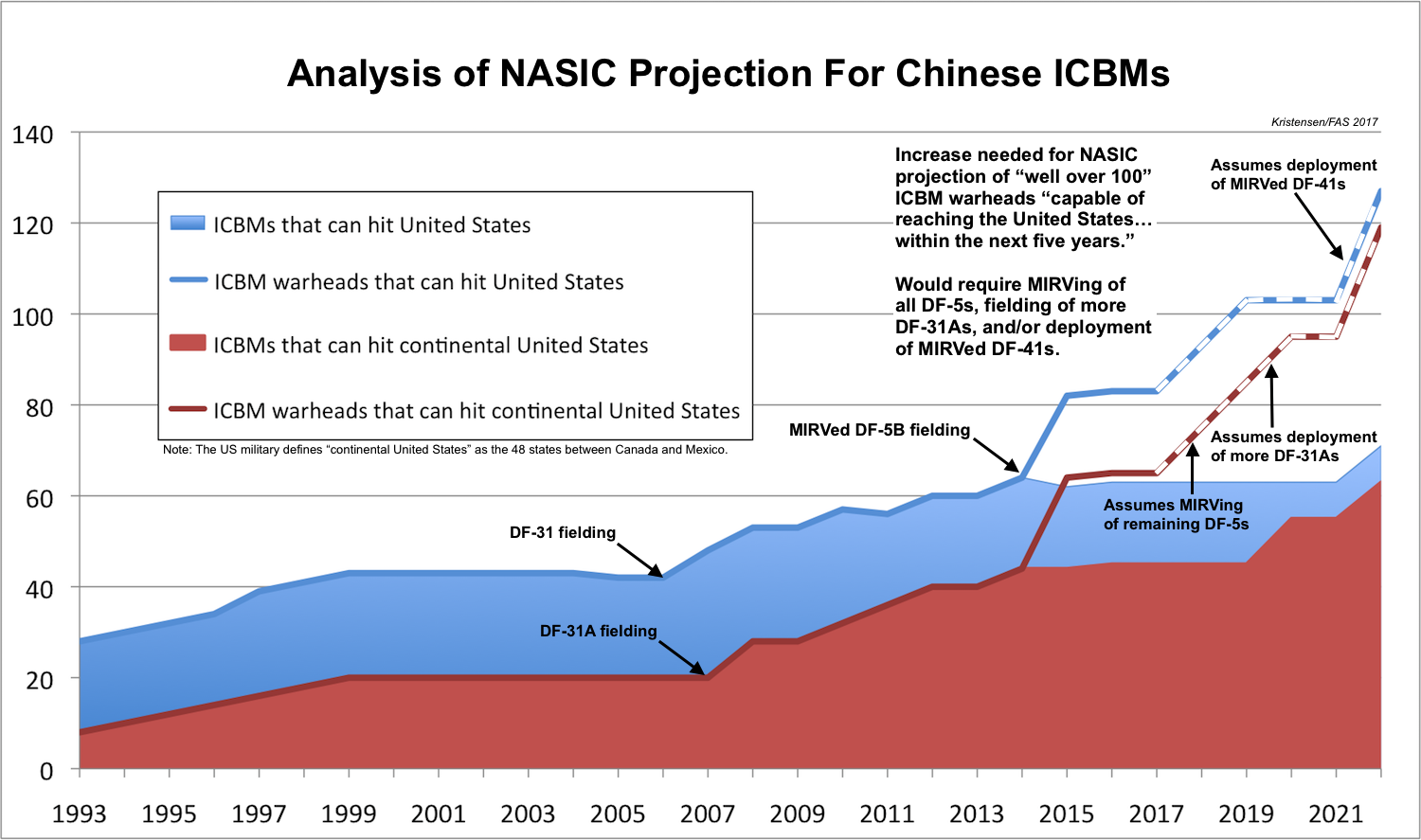China’s New DF-26 Missile Shows Up At Base In Eastern China
Pictures taken recently by Maxar Technologies’ satellites show a large number of launchers for the DF-26 intermediate-range missile operating at a training site approximately 9 kilometers (5.7 miles) south of Qingzhou City in China’s Shandong Province.
This is the first time the DF-26 has been seen operating in the area and marks a new phase in the integration of the missile into the Chinese military. The DF-26 is dual-capable, which means it can deliver both nuclear and conventional warheads and is thought to have a range of approximately 4,000 kilometers (2,490 miles). The DF-26 was first fielded in 2016 and the Pentagon’s 2019 report on Chinese military developments estimated China has up to 80 DF-26 launchers with 80-160 missiles (each launcher may have one reload).
The DF-26 is an INF-weapons, which means its range puts it in the category of ground-launched missiles that Russia and the United States banned in their arsenals for 32 years until Russia violated the treaty and the United States withdrew in protest.
China’s first DF-26 brigade stood up in April 2018 approximately 630 kilometers (390 miles) southwest of Qingzhou outside Xinyang in Henan Province. Over the past two years, DF-26s have appeared at several locations across China and significant production is visible at a factory outside Beijing.
DF-26 Sightings At Qingzhou
The Qingzhou site has been active for many decades and appears to be part of a missile support base operated by the People’s Liberation Army Rocket Force (PLARF). CIA initially identified the location as I-TU, a misspelling of its former name Yidu County, since changed to Qingzhou. The main base is located in the southwest district of the city [36.6774°, 118.4541°] and includes three large high-bay garages for servicing missile launchers. Over the years, several nuclear missile launchers have been seen operating there: DF-3A IRBM, DF-21 SRBM, DF-31/A ICBM, and now DF-26 IRBM.
The facility where the DF-26s recently appeared is about 9 kilometers (5.7 miles) of Qingzhou to the south near a location identified on Google Earth as Zhuanghanmiaocun. The DF-26 launchers first appeared there on satellite images in November 2019, when a dozen launchers were seen. In early January 2020, Google Earth loaded a Maxar image dated December 11, 2019 (note: image dates displayed on Google Earth are for some reason one day early compared to the actual date the image was taken), which was first described by Twitter user @DexReloaded. During December, several images taken by Maxar satellites show up to 18 DF-26 launchers, approximately the same number that was displayed at Xinyang in 2018 and at Jilantai in 2019.
The most recent image dated January 8, 2020, shows two groups of DF-26 launchers: one to the north (36.6026°, 118.4803°), between garages and on an old DF-3A circular launch pad; and a second group to the south (36.5999°, 118.4835°) on a cleared space where a former DF-31 launch pad is still visible. Also visible on the image are numerous support vehicles needed to support or repair the launchers when deployed. The DF-26 launchers are probably at the site as part of their integration into a new brigade.
DF-26 Sightings Elsewhere
As mentioned above, China stood up its first DF-26 unit in 2018. An image from the activation ceremony shows 24 trucks parked under a temporary cover: 18 DF-26 TELs and 4 support vehicles. If each brigade has 18 launchers, then the 80 launchers reported by the Pentagon would be sufficient for four brigades. Not all have become operational yet but DF-26s are beginning to appear at various sites across China: Xinyang (Henan), Qingzhou (Shandong), Dengshahe (Liaoning), Korla (Xinjiang), possibly Jinhua (Anhui), and the large training area at Jilantai (Inner Mongolia).
The standing up of the first DF-26 brigade at Xinyang in April 2018 was announced on Chinese news media with pictures and videos from the ceremony. But even before that, in January 2018, DF-26 launchers showed up at the field training site of the 651st Brigade near Dengshahe northeast of Dalian (Liaoning).
Then, in January 2019, Chinese media announced that DF-26s had carried out an exercise in the “Northwest China’s plateau and desert areas.” The operation was later geo-located to the large new training area west of Jilantai (Inner Mongolia), where they continued to train in April-May 2019 together with DF-41s, DF-31AGs, and DF-17s before being shipped to Beijing for the parade in September 2019.
DF-26 training at Jilantai has been a favorite propaganda tool for the Chinese government with several test-launches shown on various news media outlets (here and here). A propaganda documentary jointly produced by the Political Bureau of the Central Military Commission and the PLA News and Communication Center and broadcast by CCTV by the end of 2019 included a brief clip showing a DF-26 launch. The launch site is geolocated in the figure below:
During those months, DF-26 launchers were also seen operating at the 646 Brigade base in Korla (Ku’erle) in the Xinjiang province in western China. The first launcher was seen in April and two more in August 2019 (see image below).
DF-26 Production And Numbers
The Pentagon estimated in 2019 that China had fielded up to 80 DF-26 launchers. Not all of those are fully operationally deployed; some brigades are still being equipped. Noted China military expert Mark Stokes estimated maybe two or three DF-26 brigades a year ago, each with 6-12 launchers. So the display of 18 launchers at Xinyang and Qingzhou is obviously interesting: did it include 6-12 launchers from a second brigade or will DF-26 brigades have more launchers?
Eighteen launchers were also the number seen operating at Jilantai.
DF-26 launchers are produced at a factory near Fangshan in the outskirt of Beijing. The factory has been expanded significantly during the past decade with several large vehicle assembly halls added. The factory also appears to be involved in the production of DF-21 MRBM launchers as well as various air-defense systems. The main parking area for DF-26 launchers is in the middle of the southern end of the complex (see image below).
The first DF-26 launcher at Fangshan appeared on satellite images in March 2009 and four or five launchers were normally visible through 2016 when deployment began. The number of visible launchers increased in late-2017 and early-2018 to 15-25, and increased in late-2018 and early-2019 to 20-38 launcher, until reaching 51 visible launchers in early September 2019. Not all of the launchers seen were fully assembled; of the 51 launchers visible in September 2019, for example, only 38 appeared to be complete. The various stages of assembly are clearly visible on the images (see image below).
How does the Pentagon’s China report get to 80 DF-26 launchers? The report doesn’t explicitly say the 80 are fielded or deployed and the operational brigades and launchers seen at training areas do not add up to 80 – that number is less than 60. It seems likely the DOD estimate includes at least some of the launchers in production at Fangshan. As illustrated above, those launchers include some that are not finished but at various stages of assembly.
If one adds up all the Fangshan launchers that appear complete (those with missile canister installed), the number was about 40 in mid-2018, when DOD reported 16-30 launchers. By mid-2019, when DOD reported 80 launchers, the total number of completed launchers at Fangshan was about 50. Such a count does not accurately show how many launchers were complete because the available images were not evenly distributed over time; some were taken only a few days or weeks apart and there were month-long gaps between others. Nonetheless, it does indicate that the DOD estimate of 80 launchers likely included complete launchers at the Fangshan factory in addition to those deployed at the brigade bases and training areas.
DF-26 Implications
The “new” about the DF-26 is not that it can target Guam (other missiles have been able to do so for decades); it is that it can do so with an accurate conventional warhead. But there are also other reasons why the deployment of additional new DF-26s at Qingzhou and other locations, as well as the considerable production that is underway, is important.
The first reason is the growing size and diversity of the Chinese nuclear arsenal. China officially maintains what it calls a minimum deterrent focused on ensuring it has a secure retaliatory capability to respond to a nuclear attack. Compared with Russia and the United States, the Chinese nuclear arsenal is small; but compared with France, Britain, and India, the Chinese arsenal is significant. And it is increasing further with China about to overtake France as the world’s third-largest nuclear-weapon state. China’s arsenal has nearly doubled over the past 15 years and is expected to increase further over the next decade, although perhaps not as much as some say. There is no indication China is seeking numerical parity (or near-parity) with Russia and the United States or changing its nuclear strategy. Yet the apparently open-ended growth of the Chinese nuclear arsenal is deepening uncertainty and anxiety in neighboring countries and other nuclear-armed states about China’s long-term intentions.
China’s rejection of such concerns is well-known but counterproductive because it will fuel the development and deployment of military capabilities that China will see as growing threats to its national security. The Chinese government could help alleviate concerns and worst-case response by issuing factual statements about the status and future plans for its nuclear arsenal. This would not require disclosing everything, but as a growing military power, the days are over when China can hide behind the larger nuclear powers.
A second reason the growing DF-26 deployment is important is that it is a dual-capable weapon that can deliver either a conventional or a nuclear warhead. The inability to clearly distinguish the two creates significant challenges for crisis stability and escalation scenarios. In a tense crisis or a war, Chinese readying of conventionally-armed DF-26 launchers could easily be misinterpreted as preparations to employ nuclear weapons and cause an adversary to ready its nuclear weapons unnecessarily and precipitately. If China launched a conventionally-armed DF-26, the target country might assume the worst and prematurely escalate to nuclear use. This dilemma is exacerbated by the fact that the conventional DF-26 is part of the PLARF’s conventional missile strike force intended to provide pre-nuclear strike options, a force that in a potential war with the United States would likely be subject to focused and intense conventional strikes. If the United States used conventional weapons to target what it perceived was conventional DF-26 launchers, China might conclude that the United States had attacked its nuclear forces and escalate accordingly.
A fourth reason the growing DF-26 deployment is important is that the payload section is guided and, according to DOD, is “capable of near-precision strike capability” against land targets. Retaliatory nuclear deterrence does not require near-precision, but warfighting could. As such, Chinese deployment of highly accurate, quick-strike, dual-capable weapons could further deepen uncertainty and speculations about Chinese nuclear strategy. It could potentially also influence Chinese considerations about sub-strategic uses of nuclear weapons in de-escalation scenarios.
Finally, the DF-26 deployment is important because the missile is part of China’s growing inventory of INF-range weapons. Russia’s violation of the INF treaty was probably partially a response to China’s growing inventory of INF-range missiles, and the United States used China as part of its justification for withdrawing from the INF treaty and is developing several INF missiles that it plans to deploy within range of China. Russian and US deployment of INF missiles near China will likely further stimulate China’s production of INF-range weapons and potentially result in a destabilizing INF arms race in the Pacific.
For these reasons, it is important that China provides more information about its future plans for the development of its missile forces and engage in ongoing official discussions about the scope and role of its nuclear deterrent, including INF forces. And although China is unlikely to join US-Russian strategic agreements in the foreseeable future, Beijing should already now begin to develop options for what it could offer and what it would want in return if joining such agreements in the future. This could include articulating which US (and Indian) capabilities China is most concerned about and what Beijing would offer in return for limits on them. As a goodwill gesture, China could also offer unilateral limits on its INF capabilities in return for the US and Russia not deploying new INF systems in the region. Information and limits on the dual-capable DF-26 would be a good start.
This publication was made possible by generous contributions from the Carnegie Corporation of New York, the John D. and Catherine T. MacArthur Foundation, the New Land Foundation, the Ploughshares Fund, and the Prospect Hill Foundation. The statements made and views expressed are solely the responsibility of the authors.
Military Might Takes Center Stage at Chinese 70-Year Anniversary Parade
The Chinese leadership used the 70-year anniversary of the founding of the People’s Republic of China to display a dizzying amount of military hardware during a parade in Beijing (see officially narrated video here; higher-quality video is here. Beijing is rapidly becoming the new Red Square when it comes to military displays. On the nuclear side, the display included three ICBMs, an IRBM, a SLBM, and bombers.
The parade for the first time included the long-awaited DF-41 road-mobile ICBM. A total of 16 TELs were displayed (18 have been seen), launchers that Xinhua said came from two brigades. The display of the DF-41 happens more than two decades after it was first reported in development by the Pentagon in 1997. The DF-41, which is China’s first road-mobile ICBM capable of carrying MIRV, was described by the official parade commentator as to “balancing the power and security victory.”
The DF-41 was seen operating at the Jilantai training area in April 2019 and is currently being integrated into the PLARF. With an estimated range similar to the 13,000 kilometers of the silo-based DF-5, the DF-41 will initially complement but eventually probably replace the older liquid-fuel missile. China is currently building what appears to be silos in the Jilantai area that may eventually be intended for the DF-41.
The DF-31AG ICBM also reappeared. Xinhua described it as a “second-generation” nuclear missile with “high mobility and precision.” The 16 TELs displayed were said to be from two brigades. The official parade speaker described it as a “modified DF-31A” rather than a new missile. US intelligence has consistently described the DF-31A as a single-warhead ICBM, which also seems to be the case for the DF-31AG. DF-31AGs were also seen operating in Jilantai in April. The new DF-31AG TEL will likely replace the less maneuverable DF-31A (and DF-31) TELs.
The DF-5B silo-based ICBM was also displayed, a repeat of the 2015 parade. Xinhua said the four-missile formation came from a single missile brigade established in the early 1960s that over the years has launched “dozens” of missiles. The official parade commentator reaffirmed the DF-5B is capable of carrying multiple warheads. The DF-5B was also seen operating in Jilantai in April. There are about 20 DF-5A/B ICBMs deployed. The much-rumored DF-5C did not appear.
The DF-26 dual-capable IRBM reappeared with 16 TELs described by Xinhua to come from “two missile troops.” First displayed in 2016, there are already 65-80 DF-26s deployed. The missile was seen operating in Jilantai in April.
The biggest surprise at the parade was probably the new DF-17 ballistic missile-launched hypersonic glide-vehicle, which made its first public appearance with 16 launchers. The DF-17 appears to use a modified DF-16 TEL and is possibly boosted by a DF-16 first stage. The US intelligence community has suggested the DF-17 might be dual-capable but the parade speaker described it as “conventional.”
The parade also included a unique display of JL-2 SLBMs, the first time the weapon has been publicly displayed. A total of 12 JL-2s were shown, corresponding to a full load of one of China’s six Jin-class (Type 094) SSBNs. Each JL-2 can carry one warhead. China is developing a JL-3 for its next-generation Type 096).
The parade also saw the overflight of the H-6K and H-6N bombers, although they had to fly through a thick haze of air pollution that has plagued the Beijing area for years. Xinhua called them “long-range strategic bombers” and said they are “under the command of a division of the aviation forces of the People’s Liberation Army’s air force that has carried out many major missions, including air-dropping atomic and hydrogen bombs.” The official mentioning of a nuclear mission is interesting because of reports that Chinese bombers have recently been reassigned a nuclear strike mission. The H-6N is thought to be intended to carry an air-launched ballistic missile (ALBM), a modification of the DF-21 MRBM.
The effect of US missile defenses on Chinese military planning was palpable at this year’s parade. This included the two MIRV-capable DF-5B and DF-41 ICBMs as well as the DF-17 hypersonic glide vehicle. Although there are many rumors that the DF-41 will carry 10 MIRV, that is probably exaggerated. The objective of Chinese nuclear strategy is to ensure a secure retaliatory deterrent and penetrate US missile defenses, not to maximize the number of warheads, so the number of MIRV will likely be lower, perhaps three per missile.
The challenge of using an overstocked military parade to demonstrate China’s peaceful intensions was evident in several commentators. The official parade commentator reminded that China’s missiles are “deployed in the mountains and the oceans in defense of national security and world peace.” And the Global Times front-page coverage was balanced by a selection of editorials, reviews, and comments that reminded of China’s “peaceful intent,” “world peace” and “stability,” and that there’s “no need to overreact.”
Additional background about Chinese nuclear forces:
- FAS Nuclear Notebook: Chinese Nuclear Forces, 2019
- FAS Blogs about Chinese nuclear forces
- Podcast with CSIS’ ChinaPower
- Podcast with Ploughshares Fund
- FAS Overview: Status of World Nuclear Forces
This publication was made possible by generous contributions from the Carnegie Corporation of New York, the John D. and Catherine T. MacArthur Foundation, the New Land Foundation, the Ploughshares Fund, and the Prospect Hill Foundation. The statements made and views expressed are solely the responsibility of the authors.
New Missile Silo And DF-41 Launchers Seen In Chinese Nuclear Missile Training Area
Newly acquired satellite photos acquired from Digital Globe (Maxar) show that the People’s Liberation Army Rocket Force (PLARF) is building what appears to be a new type of missile silo in the missile training area near Jilantai, possibly for use by a new ICBM.
The photos also show that 18 road-mobile launchers of the long-awaited DF-41 ICBM were training in the area in April-May 2019 together with launchers for the DF-31AG ICBM, possibly the DF-5B ICBM, the DF-26 IRBM, and the DF-21 MRBM.
Altogether, more than 72 missile launchers can be seen operating together.
China is in the middle of a significant modernization of its nuclear weapons arsenal and the Jilantai training area, which has been constructed since 2014, appears to play an important part in that modernization effort.
A New Type of Missile Silo?
The most surprising new development in the training area is the construction of what may be a new type of missile silo. I want to emphasize that there is no official confirmation the structure is a silo, but it strongly resembles one. If so, it is potentially possible it could be part of a Chinese effort to develop the option to deploy some of its new solid-fuel road-mobile ICBMs – possible the DF-41 – in silos. According to the 2019 Pentagon report on Chinese military developments, “China appears to be considering additional DF-41 launch options, including rail-mobile and silo basing.”
Construction of the silo began in June 2018. Initially, a roof was built over it to conceal details, but in May 2019 the roof was removed exposing the silo to satellite photography (see image below).
The layout of the Jilantai silo is very different from the silos seen at Wuzhai. Those silos, which are thought to be similar to about 20 operational silos hidden in the mountains of the Henan and Hunan provinces for use by the liquid-fuel DF-5A/B ICBMs, consist of a rectangular retractable lid covering the silo on a concrete pad. And they have large exhaust vents to protect the DF-5’s liquid fuel from the launch heat.
Instead, the Jilantai silo looks more like Russian ICBM silos. It is not yet complete but so far consists of what appears to be a 180-meter line-up path and a 30-meter missile loader pad next to the silo. The precise silo diameter is difficult to measure given the image resolution but appears to be 5-6 meters, which is smaller than the 8-9 meter diameter silos at Wuzhai. Moreover, the absence of exhaust vents hints the Jilantai silo might be intended for solid-fuel missiles.
The new silo design would offer a more efficient (and safe) missile loading. At the DF-5 silos, missiles are loaded by a crane, which hoists each stage off its transporter and lowers it into the silo. It is a cumbersome and lengthy procedure. Moreover, the DF-5 is propelled by liquid fuel that is stored separately and must be loaded before the missile can be launched. With the Jilantai silo design, however, the solid-fuel missile presumably would be brought in on a loader that backs up to the edge of the silo, elevates the missile, and lowers it into the silo in one piece (warhead payload is probably added later).
If the structure seen at Jilantai indeed is a new silo, it presumably would only be used for training. If the design is successful, it would likely be followed in the future by the construction of similar silos in China’s ICBM basing areas for use by operational missiles.
Extensive Missile Training
The Jilantai missile training area, which has been constructed since 2014 and is located in the south-western part of the Inner Mongolia province approximately 930 kilometers (578 miles) west of Beijing, has undergone significant changes since I described it in January. The central technical facilities continue to expand, TEL drive-through facilities are being added, and road-mobile launchers for China’s newest nuclear-capable ballistic missiles are seen more or less constantly training in the area.
This includes the new DF-41 ICBM that may be in the final phase before starting to deploy to operational PLARF brigades. The new DF-31AG ICBM is also training at Jilantai, as is the new DF-26 IRBM and the DF-21 MRBM (see image below).

Five types of ballistic missile can be seen operating in PLARF’s training area near Jilantai. Click on image to view full size.
All these systems are solid-fuel missiles on road-mobile launchers. But it is also possible – although at this point unconfirmed – that missile systems seen training at Jilantai include transporters for the silo-based DF-5B ICBM. This is a large silo-based missile that would not be able to launch from mobile launchers, but the images show unique two-part, truck-pulled trailers that resemble the DF-5B transports that were displayed at the Beijing parade in 2015 (see image below).
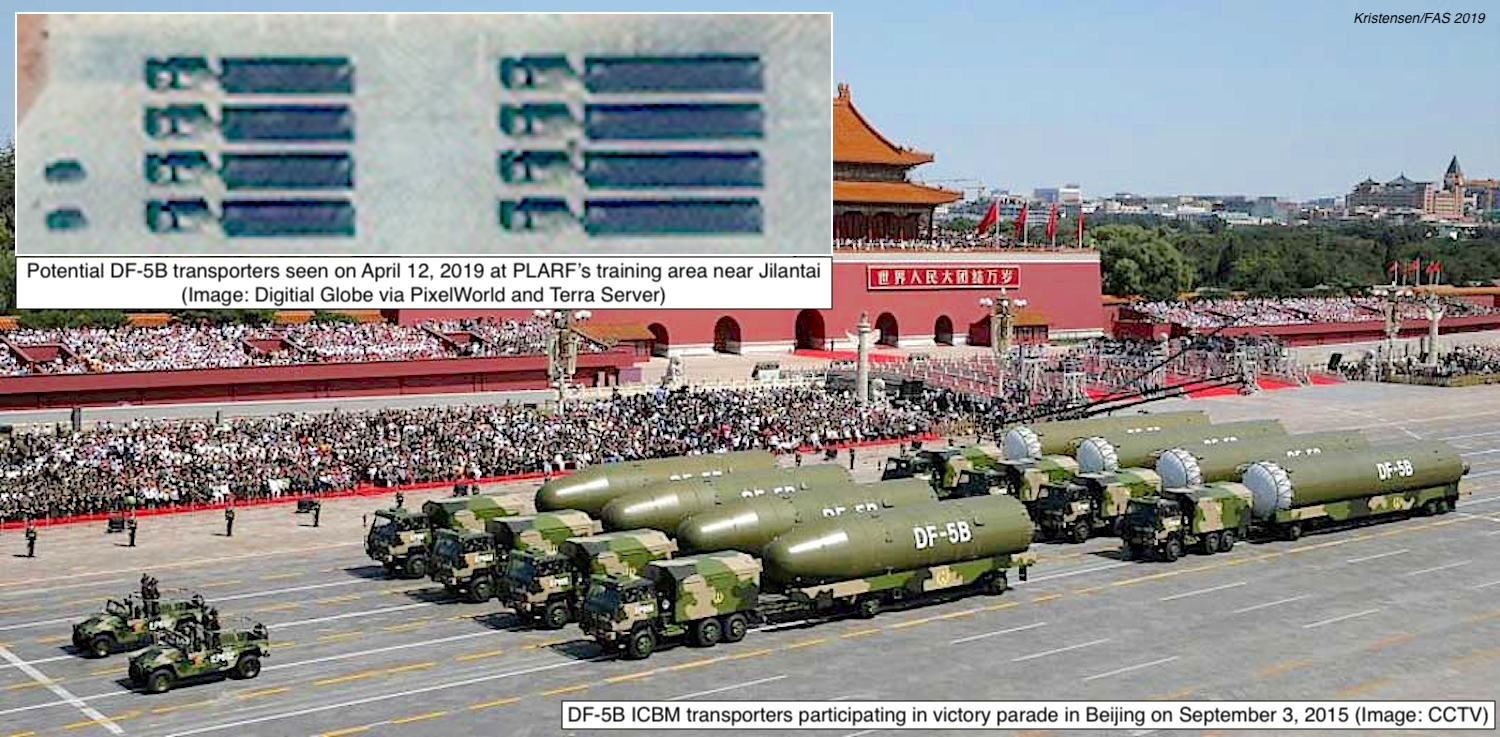
Vehicles operating at PLARF’s training center near Jilantai resemble DF-5B transporters shown in 2015 parade (click on image to view full size)
It must be underscored that there is no confirmation the trailers are for the DF-5B. In one photo some of the trailers are longer and it is unclear why DF-5B transporters would be training at Jilantai given there are no DF-5B silos in the area. If the towed trailers are not DF-5Bs, they could potentially be transporters of reload missile for the road-mobile launchers seen on the satellite photos.
The DF-41 ICBM
The satellite images indicate that the DF-41 TELs started training at Jilantai in April 2019 shortly after a new TEL drive-through highbay facility was completed (a second is under construction further to the north). There appear to be 18 DF-41 launchers. In one photo from April 17, 2019, for example, a column of 15 DF-41s can be seen making its way from the new drive-through facility (two additional DF-41s can still be seen at the facility and the 18th is probably still inside) to a parade strip to join an assembly of 18 DF-31AGs, 18 DF-26s, and 5 (possibly) DF-5B transporters.
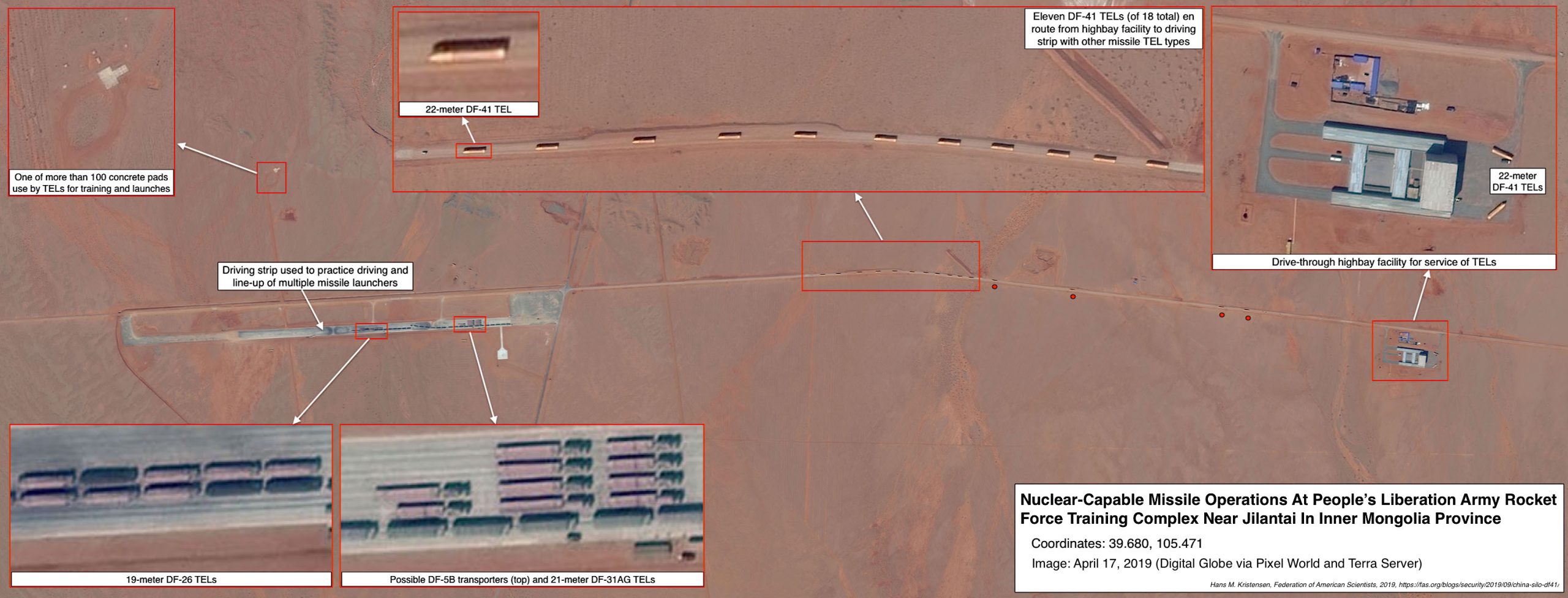
Eighteen DF-41 TELs were operating at PLARF’s training site in April this year. Click on image to view full size.
The DF-41 has been in development for a very long time. The Pentagon’s annual report on Chinese military developments first mentioned the missile in 1997 and sensational news articles have claimed it has been operational for years. The DF-41 was widely expected to be displayed at the 2015 military parade in Beijing, but that didn’t happen. Nor was it displayed at the PLA’s anniversary parade in 2017.
The DF-41 training at Jilantai with the other launchers is probably part of the formal integration of the new missile into PLAFRF service, more than two decades after development began. It seems likely that the DF-41 will appear at the military parade in Beijing on October 1st. Indeed, two months after the training occurred at Jilantai, 18 DF-41 launchers (potentially the same 18) could be seen on a satellite photo of a military facility in Yangfang about 35 kilometers (22 miles) northwest of Beijing apparently getting ready for the October parade. The image first made its way onto the Internet on August 9th, when it was posted by the Twitter user @Oedosoldier. The image carried the user’s logo but it was a screenshot from a Digital Globe image on TerraServer dated July 4, 2019.
Chinese Nuclear Missile Outlook
The highly visible display and clustering of more than 72 missile launchers at Jilantai in April and May indicate the PLARF wants them to be seen and is keenly aware that satellites are watching overhead. This is Beijing’s way of telling the world that it has a capable and survivable nuclear deterrent.
Once they become operational, the 18 DF-41s seen on the satellite photos will probably form two or three brigades and join the existing force of 65-90 DF-5A/B, DF-31/A/AG, and DF-4 ICBMs.
Despite the visible display, there is considerable uncertainty about the future development of the Chinese nuclear arsenal, not least how many missiles China plans to deploy. It seems possible the DF-41 over time might replace one or more of the older ICBMs. It is potentially also possible that the DF-31AG will replace the older DF-31/A trailer launchers (the DF-31 is notably absent from the Jilantai images). And the old DF-4 seems likely to be retired in the near future.
The US Defense Intelligence Agency (DIA) stated in May this year that, “Over the next decade, China is likely to at least double the size of its nuclear stockpile…” Part of that projection hinges on the DF-41 adding MIRV capability to the solid-fuel road-mobile missiles for the first time (the DF-5B is already equipped with MIRV).
Whether DIA’s projection comes true remains to be seen; the agency has been notoriously bad about Chinese nuclear warhead projections in the past. At this point, the Chinese arsenal is estimated to include roughly 290 warheads, a fraction of the U.S. and Russian nuclear arsenals. To put things in perspective, all the launchers seen on the satellite photos make up less than half of the number of launchers in one of the three US ICBM wings.
Nonetheless, China is modernizing and increasing its nuclear arsenal. And the activities captured by commercial satellites at the PLARF’s training area west of Jilantai – operations of new DF-41 and DF-31AG ICBMs, the new dual-capable DF-26 IRBM, and the construction of what might be a new type of missile silo – are visual reminders of the important developments currently underway in China’s nuclear posture.
Additional background:
FAS Nuclear Notebook: Chinese nuclear forces, 2019
This publication was made possible by generous contributions from the Carnegie Corporation of New York, the John D. and Catherine T. MacArthur Foundation, the New Land Foundation, the Ploughshares Fund, and the Prospect Hill Foundation. The statements made and views expressed are solely the responsibility of the authors.
New Chinese White Paper Subtly Criticizes Trump’s Approach to Arms Control
On July 22nd, China published its latest Defense White Paper––an infrequent, but significant, military policy document meant for an international audience.
This year’s paper––entitled “China’s National Defense in the New Era”––offers an assessment of the evolving strategic landscape and highlights China’s responses to these new challenges. While the paper takes a more assertive tone than its predecessor (published in 2015), the content isn’t particularly provocative––especially in the sections about nuclear weapons and deterrence, which largely constitute a repetition of the 2015 language.
The white paper states:
China is always committed to a nuclear policy of no first use of nuclear weapons at any time and under any circumstances, and not using or threatening to use nuclear weapons against non-nuclear-weapon states or nuclear-weapon free zones unconditionally. China advocates the ultimate complete prohibition and thorough destruction of nuclear weapons. China does not engage in any nuclear arms race with any other country and keeps its nuclear capabilities at the minimum level required for national security. China pursues a nuclear strategy of self-defense, the goal of which is to maintain national strategic security by deterring other countries from using or threatening to use nuclear weapons against China.
It also states:
Nuclear capability is the strategic cornerstone to safeguarding national sovereignty and security. China’s armed forces strengthen the safety management of nuclear weapons and facilities, maintain the appropriate level of readiness and enhance strategic deterrence capability to protect national strategic security and maintain international strategic stability.
This language is pretty standard for official Chinese statements about its nuclear policy. This makes sense; although China’s nuclear weapons arsenal is slowly growing and diversifying, its nuclear doctrine appears to be relatively consistent.
In reality, the main difference between the 2015 and 2019 language on nuclear weapons and arms control is in China’s assessment of the “international strategic landscape.” The paper notes that the United States has “adopted unilateral policies,” “provoked and intensified competition among major countries, significantly increased its defense expenditure, pushed for additional capacity in nuclear, outer space, cyber and missile defense, and undermined global strategic stability.”
It also specifically calls out NATO enlargement, EU integration and Russian nuclear modernization––criticisms which were all absent in the 2015 white paper.
Interestingly, it notes that “International arms control and disarmament efforts have suffered setbacks, with growing signs of arms races.” The paper additionally subtweets the Trump administration’s role in undermining global arms control, stating that “The Iranian nuclear issue has taken an unexpected turn,” “The international nonproliferation regime is compromised by pragmatism and double standards,” and concludes that “No country can respond alone or stand aloof.”
The white paper doesn’t go into detail about China’s nuclear or missile forces, only noting that the PLA Rocket Force has commissioned the DF-26 “intermediate and long-range ballistic missile.” Despite it being a relatively new missile, we estimate that China has deployed approximately 70 DF-26s––at least two brigades––and it was spotted conducting exercises in Inner Mongolia in January 2019. The 4,000 kilometer range of the DF-26 would allow China to target US bases in Guam, and some Chinese analysts claim that the missile is capable of targeting ships at sea, despite the significant tactical and procedural challenges involved with such an operation.
Read all about China’s nuclear forces in our latest edition of the FAS Nuclear Notebook, freely available at the Bulletin of the Atomic Scientists.
This publication was made possible by generous contributions from the Carnegie Corporation of New York, the John D. and Catherine T. MacArthur Foundation, the New Land Foundation, the Ploughshares Fund, and the Prospect Hill Foundation. The statements made and views expressed are solely the responsibility of the authors.
DIA Estimates For Chinese Nuclear Warheads
During a Hudson Institute conference on Russian and Chinese nuclear modernizations, director of the Defense Intelligence Agency (DIA) Lt. Gen. Robert Ashley said in prepared remarks: “Over the next decade, China is likely to at least double the size of its nuclear stockpile…”
This projection is new and significantly above recent public statements by US government agencies. But how reliable is it and how have US agencies performed in the past?
The public record is limited because estimates are normally classified and agencies and officials are reluctant to say too much. But a few examples exist from declassified documents and public statements. These estimates vary considerably – some seemed downright crazy.
But before analyzing DIA’s projection for the future, let’s examine what the estimated Chinese nuclear stockpile looks like today.
Current Chinese Stockpile Estimate
While warning the Chinese stockpile will “at least double” over the next decade, Lt. Gen. Ashley’s prepared remarks did not say what it is today. But in the follow-up Q/A session, he added: “We estimate…the number of warheads the Chinese have is in the low couple of hundreds.
That estimate is close to statements made by DOD and STRATCOM nearly a decade ago. In our forthcoming Nuclear Notebook on Chinese nuclear forces (scheduled for publication in July 2019), we estimate the Chinese stockpile now includes approximately 290 warheads and is likely to surpass the size of the French nuclear stockpile (~300 warheads) in the near future.
Earlier Chinese Stockpile Estimates
Earlier projections made by US agencies of China’s nuclear stockpile have varied considerably. DIA’s estimates have consistently been higher – even extraordinarily so – than that of other agencies (see graph below). The wide range reflects an enormous uncertainty and lack of solid intelligence, which makes it even more curious why DIA would make them. This record obviously raises questions about DIA’s latest projection.
In April 1980s, for example, DIA published a Defense Estimate Brief with the title: Nuclear Weapons Systems in China. The brief, which was prepared by the China/Far East Division of the Directorate for Estimates and approved by DIA’s deputy assistant director for estimates, projected an astounding growth for China’s nuclear arsenal that included everything from ICBMs, MRBMs, SRBMs, bombs, landmines, and air-to-surface missiles. The brief concluded a curious double estimate of 150-160 warheads in the text and 360 warheads in a table and projected an increase from 596 warheads in 1989 to as many as 818 by 1994. The brief was partially redacted for many years but it has since been possible to reconstruct in its entirety because of inconsistencies in the processing of different FOIA requests.
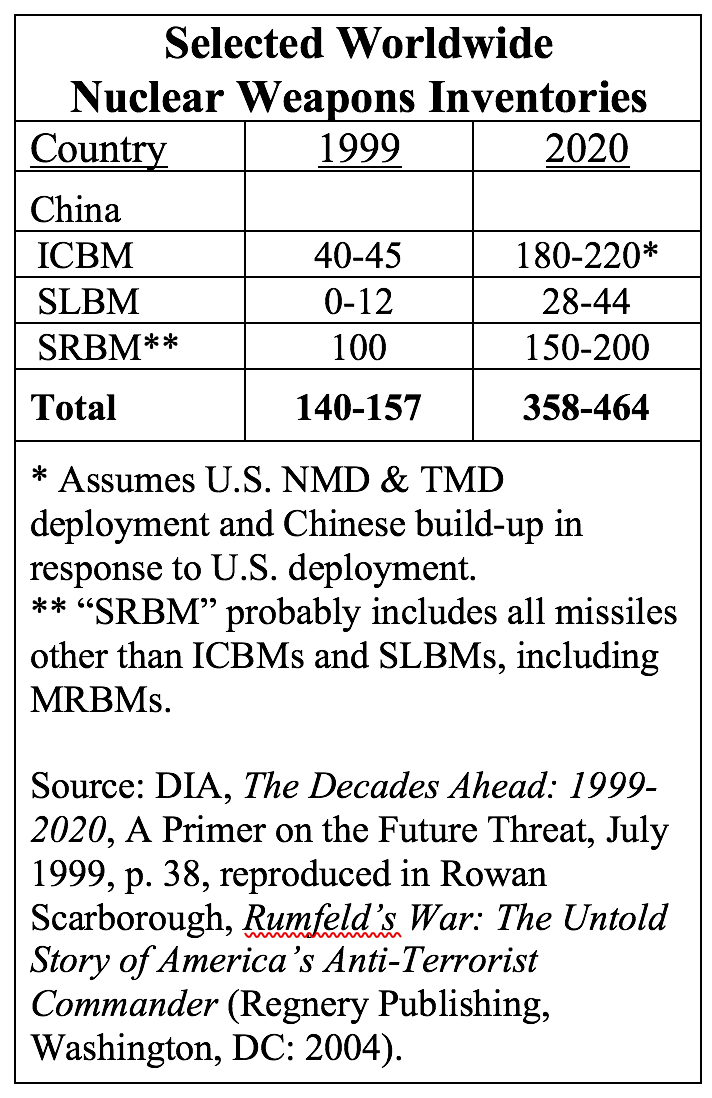 In the 1990s, CIA published three estimates, all significantly lower than the DIA projection from 1984. But DIA apparently was reworking its methodology because in 1999 it published A Primer On The Future Threat that was lower than the CIA estimate but projected an increase of the Chinese stockpile from 140-157 warheads to 358-464 warheads in 2020. The Primer predicted that deployment of US missile defenses would cause China to significantly increase its ICBM force, a prediction that has come through to some extent and is now ironically used by DIA and others to warn of a growing Chinese nuclear threat against the United States.
In the 1990s, CIA published three estimates, all significantly lower than the DIA projection from 1984. But DIA apparently was reworking its methodology because in 1999 it published A Primer On The Future Threat that was lower than the CIA estimate but projected an increase of the Chinese stockpile from 140-157 warheads to 358-464 warheads in 2020. The Primer predicted that deployment of US missile defenses would cause China to significantly increase its ICBM force, a prediction that has come through to some extent and is now ironically used by DIA and others to warn of a growing Chinese nuclear threat against the United States.
Following an intense debate in 2010 about Senate approval of the New START treaty, then-principle deputy undersecretary of defense for policy James Miller told Congress in 2011: “China is estimated to have only a few hundred nuclear weapons….”
And when false rumors flared up in 2012 that China had hundreds – even thousands – of warheads more than commonly assumed, STRATCOM commander Gen Kehler rebutted the speculations saying: “I do not believe that China has hundreds or thousands more nuclear weapons than what the intelligence community has been saying,” which is “that the Chinese arsenal is in the range of several hundred” nuclear warheads.
Since then, China has started to deploy the modified silo-based DF-5B ICBM that is equipped with multiple warheads (MIRV) – part of the response to the US missile defenses that DIA predicted in 1999, and deployed a significant number of dual-capable DF-26 IRBMs. Even so, Ashley’s most recent statement roughly matches the estimates made by Miller and Kehler nearly a decade ago, when he says: “We estimate…the number of warheads the Chinese have is in the low couple of hundreds.”
How Could The Chinese Stockpile More Than Double?
Although Ashley predicted a significant expansion of the Chinese stockpile, he did not explain the assumptions that go into that assessment. What would China have to do in order to more than double its stockpile over the next decade?
There are several potential options. China could field a significant number of additional launchers, or deploy significantly more MIRVs on some of its missiles, or – if the MIRV increase is less dramatic – a combination of more launchers and more MIRV. It seems likely to be the latter option.
Additional MIRVing seems to be an important factor. China is developing the road-mobile DF-41 ICBM that is said to be capable of carrying MIRV. It is also developing a third modification of the silo-based DF-5 (DF-5C) that may have additional MIRV capability compared with the current DF-5B. Finally, the next-generational JL-3 SLBM could potentially have MIRV capability, although I have yet to see solid sources saying so. There are many rumors about up to 10 MIRV per DF-41 (even unreliable rumors about MIRV on shorter-range systems), but if China’s decision to MIRV is a response to US missile defenses (which DIA and DOD have stated for years), then it seems more likely that the number of warheads on each missile is low and the extra spaces used for decoys.
China is also expanding its SSBN fleet, which could potentially double in size over the next decade if the production of the next-generation Type-096 gets underway in the early-2020s. And China reportedly has reassigned a nuclear mission to its bombers, is developing a new nuclear-capable bomber, and an air-launched ballistic missile that might have a nuclear option. Assuming a few bomber squadrons would a nuclear capability by the late-2020s, that could help explain DIA’s projection as well. Altogether, that adds up to a hypothetical arsenal that could potentially look like this in order to “at least double” the size of the stockpile:
Conclusions
Whether DIA’s projection comes through of a Chinese stockpile “at least double” the size of the current inventory remains to be seen. Given DIA’s record of worst-case predictions, there are good reasons to be skeptical. It would, at a minimum, be good to hear what the coordinated Intelligence Community assessment is. Does the Director of National Intelligence agree with this projection?
That said, the Chinese leadership has obviously decided that its “minimum deterrent” requires more weapons. To that end, the debate over how much is enough, what the Chinese intentions are, and what the US response should be, are important reminders that the Chinese leadership needs to be more transparent about what its modernization plans are. Lack of basic information from China fuels worst-case assumptions in the United States that can (and will) be used to justify defense programs that increase the threat against China. The recommendation by the Nuclear Posture Review to develop a new nuclear-armed sea-launched cruise missile is but one example. Both sides have an interest in limiting this action-reaction cycle.
Even if DIA’s projection of a more than doubling of the Chinse stockpile were to happen, that would still not bring the inventory anywhere near the size of the US or Russian stockpiles. They are currently estimated at 4,330 and 3,800 warheads, respectively – even more, if counting retired, but still largely intact, warheads awaiting dismantlement.
But despite the much smaller Chinese arsenal, a significant expansion of the stockpile would likely make US and Russia even more reluctant to reduce their arsenals – a reduction the Chinese government insists is necessary first before it will join a future nuclear arms limitation agreement. So while China’s motivation for increasing its arsenal may be to reduce the vulnerability of its deterrent, it may in fact also cause the United States and Russian to retain larger arsenals than otherwise and even increase their capabilities to threaten China.
Whether DIA’s projection pans out or not, it is an important reminder of the increasingly dynamic nuclear competition that is in full swing between the large nuclear weapons states. The pace and scope of that competition are intensifying in ways that will diminish security and increase risks for all sides. Strengthening deterrence is not always beneficial and even smaller arsenals can have significant effects.
This publication was made possible by generous contributions from the Carnegie Corporation of New York, the John D. and Catherine T. MacArthur Foundation, the New Land Foundation, the Ploughshares Fund, and the Prospect Hill Foundation. The statements made and views expressed are solely the responsibility of the authors.
The Pentagon’s 2019 China Report
[Updated] The Pentagon has released its 2019 version of its annual report on China’s military developments. The report describes a Chinese military in significant modernization. There is much to digest but this review only examines the nuclear portion.
The DOD report does not indicate how many nuclear warheads China has to arm these forces. Our current estimate for 2019 is approximately 290 warheads.
Although China’s nuclear arsenal is far smaller than that of Russia and the United States, the growing and increasingly capable Chinese nuclear arsenal is pushing the boundaries of China’s “minimum” deterrent and undercutting its promise that it “will never enter into a nuclear arms race with any other country.” And the more the Chinese arsenal grows, the less likely it is that Russia and the United States will significantly reduce theirs.
Land-Based Missiles
The DOD report describes a land-based missile force that is undergoing significant development with increases in almost all categories. China is clearly building up, even though it is still significantly below the nuclear force levels of Russia and the United States.
The report states that China now has 90 ICBMs (intercontinental ballistic missiles) with as many missiles. This is close to the 75-100 missiles reported for the past several years. But the number of launchers for those ICBMs is significantly higher this year: 90 versus the 50-75 listed in last year’s report. For that to be true, China would have fielded 15-40 new launchers, or the equivalent of two to six new brigades (assuming six launchers per ICBM brigade). Two or three new brigades seem more plausible so I suspect the range estimate is at the high end and might be 65-90. This increase is probably caused by the fielding of the improved road-mobile DF-31AG launcher.
Each ICBM launcher normally is attributed one missile, except in previous years the DOD reports have presented more missiles than launchers. Part of that can be explained by the old liquid-fuel roll-out-to-launch DF-4, which is thought to have at least one reload. The DOD says the DF-4 is still operational, so it’s a mystery why the table doesn’t reflect that (all other missile categories are listed with a range instead of a single number). Since 2003, DOD’s estimates for Chinese ICBMs have fluctuated considerably:
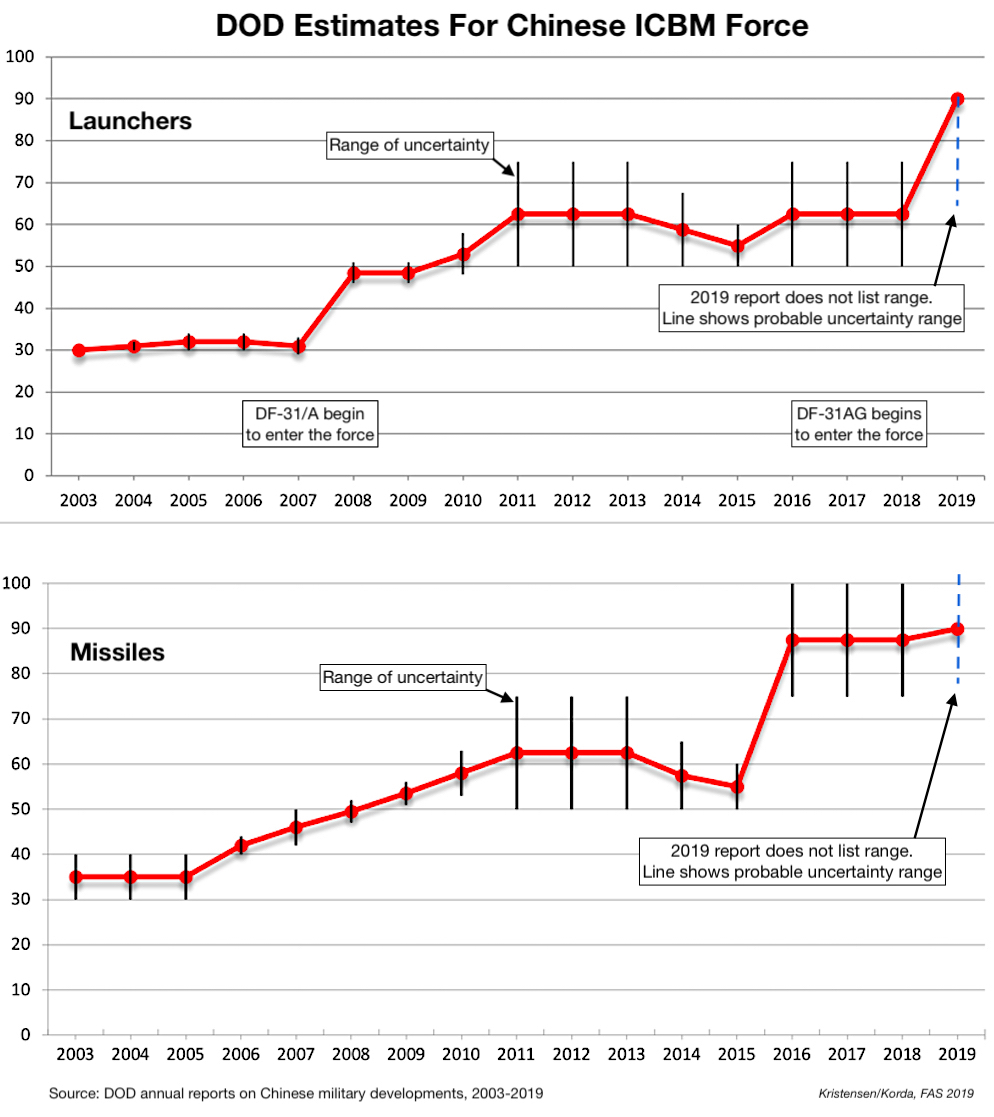
DOD’s estimates for Chinese missiles have fluctuated considerably over the years. Click on graph to view full size.
The long-awaited road-mobile DF-41 ICBM is still not listed as operational but continues development. DOD has reported this system in development since at least 1997. Once it becomes operational, this solid-fuel missile might also replace the old liquid-fuel DF-5A/B in the silos. The DF-41 is said to be MIRV-capable, as is the DF-5B. The DOD report does not mention a DF-5C version that has been rumored in some outlets.
The most dramatic development is in the IRBM (intermediate-range ballistic missile) force, which has increased significantly since last year from 16-30 launchers to 80. That indicates the dual-capable DF-26 is being fielded more rapidly than anticipated, and might now be deployed at four bases. As with the ICBMs, the IRBM launcher estimate this year is a single number rather than a range used last year, which probably means that 80 is the upper number of a 65-80 range. The Chinese media in January 2019 described a DF-26 deployment that was later geo-located to a new missile training area in the Inner Mongolia province.
The MRBM (medium-range ballistic missile) force has also increased, mainly because of the fielding of conventional versions. The DOD report lists 150 MRBM launchers with 150-450 missiles available. This includes four versions – DF-21A (CSS-5 Mod 2), DF-21C (CSS-5 Mod 4), DF-21D (CSS-5 Mod 5), and DF-21E (CSS-5 Mod 6) – of which two are nuclear: DF-21A and DF-21E (note: DOD has not yet identified the CSS-5 Mod 6 as DF-21E but it is assumed given naming of other versions). Most of the MRBMs are conventional. The report does not reveal how many of the launchers are nuclear, but it might be no more than 40-50 of the 150 MRBM launchers. There appears to be a problem with the breakdown because the DOD report states elsewhere that “the PLA is fielding approximately 150-450 conventional MRBMs.” That would imply all missiles listed in the table are conventional, which is clearly not the case.
SRBMs (short-range ballistic missiles) constitute the largest group of Chinese missiles. The number of launchers is a little lower than last year, while the uncertainty about the number of missiles available for them has increased to 750-1,500 versus 1,000-1,200 in 2018. There are many rumors on the Internet that some of China’s SRBMs (DF-11, DF-15, and DF-16) have nuclear capability. But neither the DOD report nor NASIC attributes such a capability to this group of missiles. On the contrary, the DOD report explicitly states that these weapons are part of “China’s conventional missile force.”
Finally, DOD says China has increased its ground-launched cruise missile (GLCM) force from 40-55 launchers in 2018 to 90 today. The missiles available for those launchers has increased from 200-300 to 270-540, so a significant uncertainty. The GLCM is not nuclear-capable.
The SSBN Fleet
China currently operates four Jin-class (Type 094) SSBNs (nuclear-powered ballistic missile submarines) with two more fitting out. The four operational SSBNs are all based at the Longpo Naval Base on Hainan Island. The information about the fifth and sixth hulls is new and expands observations of a fifth hull in 2018. Once completed, this force will be capable of carrying up to 72 JL-2 SLBMs with as many warheads, 24 more than the four operational can currently carry.
The Pentagon report says the four operational SSBNs “represent China’s first credible, sea-based nuclear deterrent,” although the report doesn’t say if the submarines are armed with missiles under normal circumstances, if the warheads for those missiles are installed, or if the submarines sail on deterrent patrols.
The six Jin-class SSBNs will be followed by a next-generation SSBN known as Type 096, which DOD projects might begin construction in the early-2020s. The new SSBN class will carry the follow-on JL-3 SLBM but China will probably operate the two types concurrently.
The Bomber Force
The annual DOD reports have become more specific about the nuclear role of Chinese bombers in recent years. While the 2017 version said the “PLAAF does not currently have a nuclear mission,” the 2018 report said “the PLAAF has been newly re-assigned a nuclear mission” and that the “H-6 and future stealth bomber could both be nuclear capable.”
We have for years assessed that part of the Chinese H-6 bomber force had a dormant nuclear capability with a small number of bombs in storage. Aircraft, including the H-6, were used to deliver at least 12 of the nuclear weapons that China detonated in its nuclear testing program between 1965 and 1979, and a variety of what’s said to be tactical and strategic bombs can be seen displayed in Chinese museums.
The new report references unidentified “Chinese media” saying since 2016 that the upgraded H-6K is a dual nuclear-conventional bomber. The report says China is fielding the H-6K in greater numbers with land-attack cruise missiles and more efficient engines. Armed with cruise missiles, the H-6K can target Guam, the report says. Some H-6Ks are being equipped with air-refueling capability, and a new refuellable bomber is said to be in development that could reach initial operational capability before the next-generation H-20 bomber.
The DOD report does not identify any of China’s air-launched cruise missiles (ALCMs) as nuclear-capable. An Air Force Global Strike Command command briefing in 2013 listed the CJ-20 as nuclear-capable and a DOD fact sheet published along with the 2018 Nuclear Posture Review lists both nuclear ALCM and SLCM (sea-launched cruise missile) under China. But neither NASIC nor the public annual threat assessments from the Intelligence Community have attributed nuclear capability to Chinese ALCMs or SLCMs.
US officials have publicly identified two new Air-Launched Ballistic Missiles (ALBMs) in development, “one of which may include a nuclear payload.” The ALBM, designated by the US Intelligence Community as CH-AS-13, would be carried on a modified H-6 known as H-6N, potentially the new refuellable bomber that might become operational before the H-20.
These developments, if and when they become fully operational, would give China a real nuclear Triad for the first time.
The Road Ahead
In 2004, the Chinese government declared: “Among the nuclear-weapon states, China…possesses the smallest nuclear arsenal.” The wording “nuclear-weapon states” probably referred to the five NPT-declared nuclear weapon states.
But the growing and increasingly capable Chinese nuclear arsenal is pushing the boundaries of China’s “minimum” deterrent and undercutting its promise that it “will never enter into a nuclear arms race with any other country.”
China might not consider itself to be in a formal arms race with any particular country, but it is clear that the United States is seen as the primary driver. Since 2004, the size of China’s nuclear arsenal has surpassed that of Britain and we project that China in the near future will surpass France as the world’s third-largest nuclear-armed state – although it will still be far below the levels of the nuclear arsenals of Russia and the United States.
President Trump recently declared his interest in including China in a future nuclear arms limitation agreement. His instinct is correct but it’s entirely unclear what he would offer China in return for limits on China’s nuclear forces, given how much smaller China’s arsenal is. Moreover, it should not be done at the expense of deciding now to extend the New START treaty with Russia. Indeed, China’s growing arsenal illustrate the importance of Russia and the United States maintaining existing arms control agreements and taking steps to reduce their arsenals further in consultations with China.
The Chinese leadership, however, can no longer hide behind the response: “Come down to our level. Then we’ll talk.” Beijing must be mindful that China’s growing nuclear arsenal – as well as its general military modernization and territorial pursuits – can serve to limit US willingness to reduce its arsenal further and may even lead to decisions to increase the capabilities. The Trump administration’s plan to abandon the INF treaty with Russia and add a nuclear sea-launched cruise missile to the arsenal are just two examples; they have China written all over it.
Additional information:
This publication was made possible by generous contributions from the Carnegie Corporation of New York, the John D. and Catherine T. MacArthur Foundation, the New Land Foundation, the Ploughshares Fund, and the Prospect Hill Foundation. The statements made and views expressed are solely the responsibility of the authors.
Rising China Sells More Weapons
“In 2018, China’s arms sales increased, continuing a trend that enabled China to become the world’s fastest-growing arms supplier during the past 15 years,” according to the 2019 China Military Power report published by the Department of Defense. “From 2013 through 2017, China was the world’s fourth-largest arms supplier, completing more than $25 billion worth of arms sales.”
“Arms transfers also are a component of China’s foreign policy, used in conjunction with other types of military, economic aid, and development assistance to support broader foreign policy goals,” the Pentagon report said. “These include securing access to natural resources and export markets, promoting political influence among host country elites, and building support in international forums.”
Needless to say, the United States and other countries have long done the same thing, using arms exports as an instrument of foreign policy and political influence. Up to a point, however, US arms sales are regulated by laws that include human rights and other considerations. See U.S. Arms Sales and Human Rights: Legislative Basis and Frequently Asked Questions, CRS In Focus, May 2, 2019.
To assist soldiers in identifying Chinese weapons in the field, the US Army has produced a deck of “playing cards” featuring various weapons systems.
“The Worldwide Equipment Identification Playing Cards enable Soldiers to be able to readily identify enemy equipment and distinguish the equipment from friendly forces. Cards can be used at every level and across all services.” See Worldwide Equipment Identification Cards: China Edition, US Army TRADOC, April 2019.
Chinese DF-26 Missile Launchers Deploy To New Missile Training Area
[Updated Jan 31, 2019] Earlier this month, the Chinese government outlet Global Times published a report that a People’s Liberation Army Rocket Force (PLARF) unit with the new DF-26 intermediate-range ballistic missile had carried out an exercise in the “Northwest China’s plateau and desert areas.” The article made vague references to a program previously aired on China’s CCTV-7 that showed a column of DF-26 launchers and support vehicles driving on highways, desert roads, and through mountain streams.
As it turns out, the exercise may have been west of Beijing, but the actual location is in upper Central China. Several researchers (for example Sean O’Connor) have been attempting to learn more about the unit. By combining scenes from the CCTV-7 program with various satellite imagery sources, I was able to geolocate the DF-26s to the S218 highway (39.702137º, 105.731469º) outside the city of Jilantai (Jilantaizhen) roughly 100 km north of Alxa in the Inner Mogolia province in the northern part of central China (see image below).
The DF-26s appear to have been visiting a new missile training area established by PLARF since 2015. By combining use of Google Earth, Planet, and Terra Server, each of which has unique capabilities needed to scan vast areas and identifying individual facilities, as well as analyzing images purchased from Digital Globe, I have so far been able to identify more than 100 launch pads used by launchers and support vehicles during exercises, a support base, a landing strip, and at least eight launch unit camp sites covering an area of more than 1,000 square kilometers (400 square miles) along a 90-kilometer (55-mile) corridor (see image below). A Google Earth placemark file (kml) with all these locations is available for download here.
The Chinese military has for decades been operating a vast missile training area further west in the Qinghai province, which I profiled in an article a decade ago. They also appear to operate a training area further west near Korla (Beyingol). The best unclassified guide for following Chinese missile units is, of course, the indispensable PLA Rocket Force Leadership and Unit Reference produced by Mark Stokes at the Project 2049 Institute.
It is not clear if the DF-26 unit that exercised in the Jilantai training area is or will be permanently based in the region. It is normal for Chinese missile units to deploy long distances from their home base for training. The first brigade (666 Brigade) is thought to be based some 1,100 kilometers (700 miles) to the southeast near Xinyang in southern Henan province. This was not the first training deployment of the brigade. The NASIC reported in 2017 that China had 16+ DF-26 launchers and it is building more. The CCTV-7 video shows an aerial view of a launch unit camp with TEL tents, support vehicles, and personnel tents. A DF-26 is shown pulling out from under a camouflage tent and setting up on a T-shaped concrete launch pad (see image below). More than 100 of those pads have been identified in the area.
The support base at the training area does not have the outline of a permanent missile brigade base. But several satellite images appear to show the presence of DF-16, DF-21, and DF-26 launchers at this facility. One image purchased from Digital Globe and taken by one of their satellites on October 24, 2018, shows the base under construction with what appears to be two DF-16 launchers (h/t @reutersanders) parked between two garages. Another photo taken on August 16, 2017, shows what appears to be 22 DF-21C launchers with a couple of possible DF-26 launchers as well (see below).
The DF-26, which was first officially displayed in 2015, fielded in 2016, and declared in service by April 2018, is an intermediate-range ballistic missile launched from a six-axle road-mobile launchers that can deliver either a conventional or nuclear warhead to a maximum distance of 4,000 kilometers (2,485 miles). From the 666 Brigade area near Xinyang, a DF-26 IRBM could reach Guam and New Delhi (see map below). China has had the capability to strike Guam with the nuclear DF-4 ICBM since 1980, but the DF-4 is a moveable, liquid-fuel missiles that takes a long time to set up, while the DF-26 is a road-mobile, solid-fuel, dual-capable missile that can launch quicker and with greater accuracy. Moreover, DF-26 adds conventional strike to the IRBM range for the first time.
The 666 Brigade is in range of U.S. sea- and air-launched cruise missiles as well as ballistic missiles. But the DF-26 is part of China’s growing inventory of INF-range missiles (most of which, by far, are non-nuclear), a development that is causing some in the U.S. defense community to recommend the United States should withdraw from the INF treaty and deploy quick-launch intermediate-range ballistic missiles in the Western Pacific. Others (including this author) disagree, saying current and planned U.S. capabilities are sufficient to meet national security objectives and that engaging China in an INF-race would make things worse.
See also: FAS Nuclear Notebook on Chinese Nuclear Forces, 2018
This publication was made possible by a grant from the Carnegie Corporation of New York, the John D. and Catherine T. MacArthur Foundation, the New Land Foundation, and the Ploughshares Fund. The statements made and views expressed are solely the responsibility of the author.
The Pentagon’s Annual Report on Chinese Military
[Updated August 21, 2018] The Pentagon’s annual report to Congress on China’s military and security developments has finally been published, several months later than previous volumes. Normally it takes about one month after the report is generated to be published. This year it took three times that long.
The report covers many aspects of Chinese military developments. In this article I’ll briefly review the nuclear weapons related aspects of the report.
Overall, nuclear developments are not what stand out in this report. Although there are important nuclear developments, the Pentagon’s primary concern is clearly about China’s conventional forces.
Nuclear Policy and Strategy
The DOD report repeats the conclusion from previous reports that China has not, despite writings by some PLA officers (and occasional speculations by outside analysts), changed its nuclear policy but retains a no-first-use (NFU) policy and a pledge not to use nuclear weapons against any non-nuclear weapon state or in nuclear-weapon-free zones. That would, strictly speaking, include Japan, even though it hosts large numbers of U.S. forces.
The NFU policy, DOD says, has “contributed to the construction of [underground facilities] for the country’s nuclear forces, which plan to survive an initial nuclear strike.” Stimulants for the tunneling efforts were the 1991 Gulf War and 1999 Kosovo war, which made the Chinese realize how vulnerable their forces would be in a war with the United States.
Nor does the report indicate China has yet mated nuclear warheads to its missiles or placed nuclear forces on alert under normal circumstances. The report repeats the assessment from last that “China is enhancing peacetime readiness levels for these nuclear forces to ensure responsiveness.” That responsiveness is thought to ensure the force can disperse and go on alert if necessary.
The report mentions unidentified PLA writings expressing the value of a “launch on warning” nuclear posture, but it does not say China has adopted such a posture. A launch on warning posture would require high readiness of nuclear forces to be able to launch as soon as a warning of an incoming nuclear attack was received. China already has a “ready the forces on warning” posture that involves gradually raising the readiness level in response to growing tension in a crisis.
In U.S. military terminology, “launch on warning” is a higher readiness level than “launch under attack” because it would involve being able to launch upon detection that an attack was imminent but before incoming missiles had been detected. “Launch under attack,” in contrast, would require the force to be able to launch before incoming warheads hit U.S. launchers. The DOD report says the PLA writings highlight the “launch on warning” posture would be consistent with China’s no-first-use policy, which would imply it is more compatible with a “launch under attack” posture.
The DOD report also continues to describe China’s work on MIRV, the capability to equip missile with multiple independently targetable reentry vehicles. Rather than a sign of an emerging counterforce strategy, however, DOD states that the purpose of the Chinese MIRV program is to “ensure the viability of its strategic deterrent in the face of continued advances in U.S. and, to a lesser extent, Russian strategic ISR, precision strike, and missile defense capabilities.”
Indeed, the counterproductive effects of U.S. ballistic missile defenses on Chinese offensive force developments is clearly spelled out in the report: “The PLA is developing a range of technologies China perceives are necessary to counter U.S. and other countries’ ballistic missile defense systems, including MaRV, MIRVs, decoys, chaff, jamming, thermal shielding, and hypersonic glide vehicles.”
The growing inventory of ICBMs and SSBNs means that China has to improve nuclear command and control of these systems for them to be effective. It is unknown if Chinese SSBNs have yet sailed on a deterrent patrol (we assume not), much less with nuclear warheads onboard (we also assume not). But the growing and increasingly mobile ICBM force is carrying out extensive combat patrol exercises that place new demands on the nuclear command and control system.
A unique feature of the Chinese missile force is the mixing of nuclear and conventional versions of the same missiles (DF-21 and DF-26 have both nuclear and conventional roles). For China, this is a means to provide the leadership with non-nuclear strike options without having to resort to nuclear use. For China’s potential adversaries, it is a dangerous and destabilizing practice that risks causing confusion about the character of missile attacks and potentially trigger mistaken nuclear escalation in a conflict.
China has, like other nuclear-armed states, lowered the yield of its nuclear warheads as ballistic missiles became more accurate. The current warhead used on the DF-31/A ICBMs is thought to be ten times less powerful than the multi-megaton warhead developed for the DF-5. Moreover, as China seeks to ensure the survivability of its warheads against missile defense systems, it is likely to continue to try to reduce the weight and size of its warheads to maximize penetration aids on the missiles.
The DOD report mentions a “defense industry publication has also discussed the development of a new low-yield nuclear weapon,” but does not provide any details about the publication or what it said. The classified version apparently has more details.
The Land-Based Missile Force
The overall number of Chinese ICBM launchers reported by DOD has remained stable since 2011: 50-75. One type (DF-4) has reload capability, so the number of available missiles is a little higher: 75-100 missiles. That number has also remained stable for the past three years. Indeed, other than the arrival of the DF-26 IRBM force, the total Chinese rocket forces estimate is identical to that of presented in the 2017 report.
This indicates that the DF-31A force is not continuing to increase, that the DF-31AG has not yet been operationally deployed (or is replacing older DF-31s on a one-for-one basis), and that the DF-41 is still in development more than 20 years after it was first listed in the annual DOD report.
DOD’s reporting shows that the number of Chinese ICBM launchers has roughly doubled since 2003, while the number of missile available for those launchers has more than doubled. The numbers of missiles show a mysterious increase in 2016 from just over 40 to more than 80 (see table below). The increase is curious because it does not follow the number of launchers but suddenly jumps even though there was no corresponding increase in launchers that year.
The DF-4 is thought to have reloads but that system has been deployed since the 1980s. There is considerable uncertainty in the number of launchers (some years 25). The increase coincides with the deployment of the MIRVed DF-5Bs, so a potential explanation might be that there are two full sets of DF-5 versions. But it should be underscored that it is unknown if this is the reason.
The old liquid-fuel DF-4 (CSS-3) ICBM is still listed as operational, even though the relocatable missile will probably be replaced by more survivable road-mobile missiles in the near future. The DF-4 appears to be retained in a roll-out-to-launch posture.
The old, but updated, liquid-fuel, silo-based DF-5 ICBM is still listed in two version: the single-warhead DF-5A and the MIRVed DF-5B. This missile was first deployed in the early-1980s and is based in 20 silos in the eastern part of central China. There is no mentioning of a rumored C version.
The DF-31 and DF-31A are the most modern operational ICBMs in the Chinese inventory. First fielded in 2006 and 2007, respectively, deployment of the DF-31 appears to have stalled and DF-31A is operational in perhaps three brigades. Each missile can carry a single warhead. The DF-31AG is mentioned for the first time as an enhanced DF-31 with improved launcher maneuverability and survivability but may not yet be fully operational.
The long-awaited DF-41 ICBM remains in development and is listed by DOD as MIRV-capable. The report states that China is “considering additional launch options” for the DF-41, including rail-mobile and silo-basing. In silo-based version it would likely replace the DF-5.
The medium- and intermediate-range nuclear missile force is made up of three types: the new DF-26 IRBM, which is dual-capable and able to conduct conventional (both land-attack and anti-ship) and nuclear precision attacks; and two versions of the DF-21: DF-21A and DF-21E. The DF-21 A (SSC-5 Mod 2) has been deployed since the late-1990s. The DF-21E (note: the E designation is not official but assumed) is known as the SSC-5 Mod 6 and was first reported in 2016. The DF-21 also exists in two conventional versions: DF-21C and DF-21D (anti-ship).
The dual-capable DF-26, first fielded in 2016, is capable of conducting “nuclear precision strikes against ground targets.” There appears to be one or two DF-26 brigades.
The role of the new Strategic Support Force is listed as intended to “centralize the military’s space, cyber, and EW [Early Warning] missions. These would probably support the rocket force.
The Submarine Force
The DOD report says that China still operates four Jin-class (Type 094) SSBNs (all based at Hainan), each of which can carry up to 12 JL-2 SLBMs. At least one more Jin-SSBN is said to be under construction. Construction of a new SSBN (Type 096) may begin in the mid-2020s with a new SLBM (JL-3). DOD speculates that Type 094 and Type 096 SSBNs might end up operating concurrently, which, if accurate, could increase the size of the total SSBN fleet.
China also operates five Shang-class (Type 093/A) nuclear-powered attack submarines, with a sixth under construction. The Shang has now completely replaced the old Han-class (Type 092). DOD anticipates that a modified Shang (Type 093B) equipped with land-attack cruise missiles may begin building in the early-2020s. [Note: while many public sources call the two existing Shang versions Type 093A and Type 093B, the DOD report calls them Type 093 and Type 093A. The Type 093B is listed as a future type that until 2016 was called Type 095.]
Overall, China operates 56 submarines, of which 47 are diesel-electric. The report projects this force may increase to 69-78 submarines by 2020, a significant increase in only two years.
There is no mentioning in the DOD report of the nuclear sea-launched cruise missile listed in the Nuclear Posture Review fact sheet from February 2018.
The Bomber Force
One of the most interesting nuclear developments in the DOD report is the assessment that “the PLAAF has newly been re-assigned a nuclear mission.” This contrasts with last year’s report, which stated the “PLAAF does not currently have a nuclear mission.” The “re-assignment” indicates that the bombers previous had a nuclear mission. We have estimated that a small number of bombers had a dormant nuclear capability for gravity bombs as indicated by their extensive role in the nuclear weapons testing program and China’s display of nuclear bombs in military museums.
The DOD report states that the H-6 and the future stealth bomber could both be nuclear-capable. The future bomber, according to the DOD report, could potentially be operational within the next ten years.
The report repeats the estimate made by the U.S. Intelligence Community from the past two years that China is upgrading its aircraft with two new air-launched ballistic missiles, one of which may include a nuclear payload.
The DOD report does not mention the nuclear air-launched cruise missile listed the Nuclear Posture Review fact sheet from February 2018.
Additional Background:
Review of NASIC Report 2017: Nuclear Force Developments
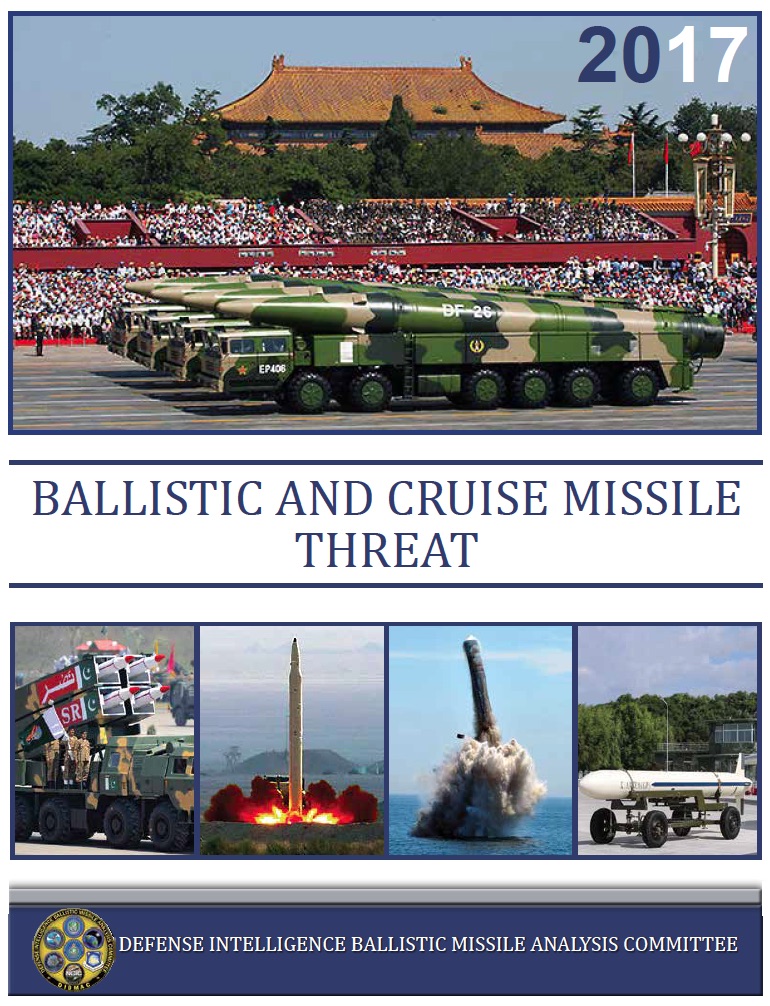
Click on image to download copy of report. Note: NASIC later published a corrected version, available here
By Hans M. Kristensen
The National Air and Space Intelligence Center (NASIC) at Wright-Patterson AFB has updated and published its periodic Ballistic and Cruise Missile Threat report. The new report updates the previous version from 2013.
At a time when public government intelligence resources are being curtailed, the NASIC report provides a rare and invaluable official resource for monitoring and analyzing the status of ballistic and cruise missiles around the world.
Having said that, the report obviously comes with the caveat that it does not include descriptions of US, British, French, and most Israeli ballistic and cruise missile forces. As such, the report portrays the international “threat” situation as entirely one-sided as if the US and its allies were innocent bystanders, so it will undoubtedly provide welcoming fuel for those who argue for increasing US defense spending and buying new weapons.
Also, the NASIC report is not a top-level intelligence report that has been sanctioned by the Director of National Intelligence. As such, it represents the assessment of NASIC rather than necessarily the coordinated and combined conclusion of the US Intelligence Community.
Nonetheless, it’s a unique and useful report that everyone who follows international security and ballistic and cruise missile developments should consult.
Overall, the NASIC report concludes: “The last decade has seen a dramatic increase in ballistic missile capabilities to include accuracy, post-boost maneuverability, and combat effectiveness.” During the same period, “there has been a significant increase in worldwide ballistic missile testing.” The countries developing ballistic and cruise missile systems view them “as cost-effective weapons and symbols of national power” that “present an asymmetric threat to US forces” and many of the missiles “are armed with weapons of mass destruction.” At the same time, “numerous types of ballistic and cruise missiles have achieved dramatic improvements in accuracy that allow them to be used effectively with conventional warheads.”
Some of the more noteworthy individual findings of the new report include:
- Russia’s nuclear modernization is, despite claims by some, not a “buildup” but the size of the Russian ICBM force will continue to decline.
- The Russian RS-26 “short” SS-27 ICBM is still categorized as an ICBM (as in the 2013 report) despite claims by some that it’s an INF weapon.
- The report is the first US official document to publicly identify the ground-launched cruise missile that Russia has developed and deployed in violation of the INF treaty: 3M-14. The weapon is assessed to “possibly” have a nuclear option. [Note: A corrected version of the NASIC report published in June removed the reference to a “ground” version of the 3M-14.]
- The Russian SS-N-26 (Oniks or Onix) anti-ship cruise missile that is currently replacing several Soviet-era cruise missiles “possibly” has a nuclear option.
- The range of the dual-capable SS-26 (Islander) SRBM is listed as 350 km (217 miles) rather than the 500-700 km (310-435 miles) often claimed in the public debate.
- The number of Chinese warheads capable of reaching the United States could increase to well over 100 in the next five years, six years sooner than predicted in the 2013 report. (The count includes warheads that can only reach Alaska and Hawaii, not necessarily all of continental United States.)
- Deployment of the Chinese DF-31/DF-31A ICBMs appears to have stalled.
- China’s long-awaited DF-41 ICBM will “possibly” be capable of carrying multiple warheads but is not yet deployed.
- Two Chinese medium-range ballistic missile types (DF-3A and DF-21 Mod 1) have been retired.
- The Chinese ground-launched DH-10 land-attack cruise missile is no longer listed as “conventional or nuclear” but only as “conventional.”
- None of North Korea’s ICBMs are listed as deployed.
Below I go into more details about the individual nuclear-armed states:
Russia
Russia is now more than halfway through its modernization, a generational upgrade that began in the mid/late-1990s and will be completed in the mid-2020s. This includes a complete replacement of the ICBM force (but at lower numbers), transition to a new class of strategic submarines, upgrades of existing bombers, replacement of all dual-capable SRBM units, and replacement of most Soviet-era naval cruise missiles with fewer types.
The NASIC report states that “Russian in September 2014 surpassed the United States in deployed warheads capable of reaching the United States,” referring to the aggregate number reported under the New START treaty. The report does not mention, however, that Russia since 2016 has begun to reduce its deployed strategic warheads and is expected meet the treaty limit in 2018.
ICBMs: Contrary to many erroneous claims in the public debate (see here and here) about a Russia nuclear “build-up,” the NASIC report concludes that “the number of missiles in the Russian ICBM force will continue to decrease because of arms control agreements, aging missiles, and resource constraints…” This conclusion fits the assessment Norris and I have made for years that Russia is modernizing its nuclear forces but not increasing the size of the arsenal.
The report counts about 330 ICBM launchers (silos and TELs), significantly fewer than the 400 claimed by the Russian military. The actual number of deployed missiles is probably a little lower because several SS-19 and SS-25 units are in the process of being dismantled.
The development continues of the heavy Sarmat (RS-28), which looks very similar to the existing SS-18. The lighter SS-27 known as RS-26 (Rubezh or Yars-M) appears to have been delayed and still in development. Despite claims by some in the public debate that the RS-26 is a violation of the INF treaty, the NASIC report lists the missile with an ICBM range of 5,500+ km (3,417+ miles), the same as listed in the 2013 version. NASIC says the RS-26, which is designated SS-X-28 by the US Intelligence Community, has “at least 2” stages and multiple warheads.
Overall, “Russia retains over 1,000 nuclear warheads on ICBMs,” according to NASIC, another assessment that fits our estimate from the Nuclear Notebook. The NASIC report states that “most” of those missiles “are maintained on alert, capable of being launched within minutes of receiving a launch order.” (In comparison, essentially all US ICBMs are maintained on alert: see here for global alert status.)
SLBMs: The Russian navy is in the early phase of a transition from the Soviet-era Delta-class SSBNs to the new Borei-class SSBN. NASIC lists the Bulava (SS-N-32) SLBM as operational on three Boreis (five more are under construction). The report also lists a Typhoon-class SSBN as “not yet deployed” with the Bulava (the same wording as in the 2013 report), but this is thought to refer to the single Typhoon that has been used for test launches of the Bulava and not imply that the submarine is being readied for operational deployment with the missile.
While the new Borei SSBNs are being built, the six Delta-IVs are being upgrade with modifications to the SS-N-23 SLBM. The report also lists 96 SS-N-18 launchers, corresponding to 6 Delta-III SSBNs. But that appears to include 3-4 SSBNs that have been retired (but not yet dismantled). Only 2 Delta-IIIs appear to be operational, with a third in overhaul, and all are scheduled to be replaced by Borei-class SSBNs in the near future.
Cruise Missiles: The report lists five land-attack cruise missiles with nuclear capability, three of which are Soviet-era weapons. The two new missiles that “possibly” have nuclear capability include the mysterious ground-launched cruise missile that Russia has developed and deployed in violation of the INF treaty. The US first accused Russia of treaty violation in 2014 but has refused to name the missile, yet the NASIC report gives it a name: 3M-14. The weapon exists in both “ground, ship & sub” versions and is credited with “conventional, nuclear possible” warhead capability. [Note: A corrected version of the NASIC report published in June removed the reference to a “ground” version of the 3M-14.]
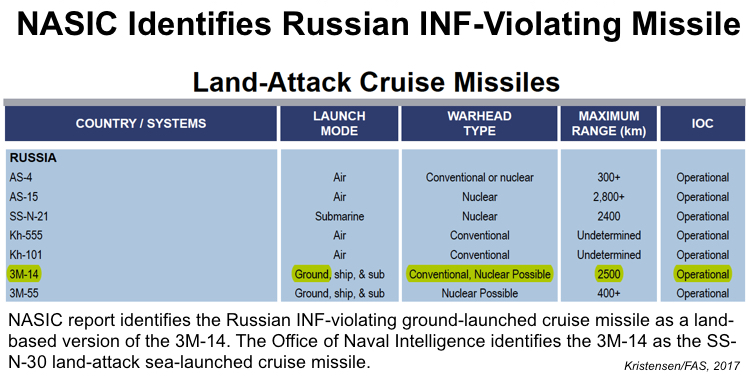
Ground- and sea-based versions of the 3M-14 have different designations. The Office of Naval Intelligence (ONI) identifies the naval 3M-14 as the SS-N-30 land-attack missile, which is part of the larger Kalibr family of missiles that include:
- The 3M-14 (SS-N-30) land-attack cruise missile (the nuclear version might be called SS-N-30A; Pavel Podvig reported back in 2014 that he was told about an 8-meter 3M-14S missile “where ‘S’ apparently stands for ‘strategic’, meaning long-range and possibly nuclear”);
- The 3M-54 (SS-N-27, Sizzler) anti-ship cruise missile;
- The 91R anti-submarine missile.
The US Intelligence Community uses a different designation for the GLCM version, which different sources say is called the SSC-8, and other officials privately say is a modification of the SSC-7 missile used on the Iskander-K. (For public discussion about the confusing names and designations, see here, here, and here.)
The range has been the subject of much speculation, including some as much as 5,472 km (3,400 miles). But the NASIC report sets the range as 2,500 km (1,553 miles), which is more than was reported by the Russian Ministry of Defense in 2015 but close to the range of the old SS-N-21 SLCM.
The “conventional, nuclear possible” description connotes some uncertainty about whether the 3M-14 has a nuclear warhead option. But President Vladimir Putin has publicly stated that it does, and General Curtis Scaparrotti, the commander of US European Command (EUCOM), told Congress in March that the ground-launched version is “a conventional/nuclear dual-capable system.”
ONI predicts that Kalibr-type missiles (remember: Kalibr can refer to land-attack, anti-ship, and/or anti-submarine versions) will be deployed on all larger new surface vessels and submarines and backfitted onto upgraded existing major ships and submarines. But when Russian officials say a ship or submarine will be equipped with the Kalibr, that can potentially refer to one or more of the above missile versions. Of those that receive the land-attack version, for example, presumably only some will be assigned the “nuclear possible” version. For a ship to get nuclear capability is not enough to simply load the missile; it has to be equipped with special launch control equipment, have special personnel onboard, and undergo special nuclear training and certification to be assigned nuclear weapons. That is expensive and an extra operational burden that probably means the nuclear version is only assigned to some of the Kalibr-equipped vessels. The previous nuclear land-attack SLCM (SS-N-21) is only assigned to frontline attack submarines, which will most likely also received the nuclear SS-N-30. It remains to be seen if the nuclear version will also go on major surface combatants such as the nuclear-propelled attack submarines.
The NASIC report also identifies the 3M-55 (P-800 Oniks (Onyx), or SS-N-26 Strobile) cruise missile with “nuclear possible” capability. This weapon also exists in “ground, ships & sub” versions, and ONI states that the SS-N-26 is replacing older SS-N-7, -9, -12, and -19 anti-ship cruise missiles in the fleet. All of those were also dual-capable.
It is interesting that the NASIC report describes the SS-N-26 as a land-attack missile given its primary role as an anti-ship missile and coastal defense missile. The ground-launched version might be the SSC-5 Stooge that is used in the new Bastion-P coastal-defense missile system that is replacing the Soviet-era SSC-1B missile in fleet base areas such as Kaliningrad. The ship-based version is replacing the SS-N-19 on the nuclear-propelled Kirov-class cruisers and Kuznetsov-class aircraft carrier. Presumably it will also replace the SS-N-12 on the Slava-class cruisers and SS-N-9 on smaller corvettes. The submarine version is replacing the SS-N-19 on the Oscar-class nuclear-propelled attack submarine.
NASIC lists the new conventional Kh-101 ALCM but does not mention the nuclear version known as Kh-102 ALCM that has been under development for some time. The Kh-102 is described in the recent DIA report on Russian Military Power.
Short-range ballistic missiles: Russia is replacing the Soviet-era SS-21 (Tochka) missile with the SS-26 (Iskander-M), a process that is expected to be completed in the early-2020s. The range of the SS-26 is often said in the public debate to be the 500-700 km (310-435 miles), but the NASIC report lists the range as 350 km (217 miles), up from 300 km (186 miles) reported in the 2013 version.
That range change is interesting because 300 km is also the upper range of the new category of close-range ballistic missiles. So as a result of that new range category, the SS-26 is now counted in a different category than the SS-21 it is replacing.
China
The NASIC report projects the “number of Chinese ICBM nuclear warheads capable of reaching the United States could expand to well over 100 within the next 5 years.” Four years ago, NASIC projected the “well over 100” warhead number might be reached “within the next 15 years,” so in effect the projection has been shortened by 6 years from 2028 to 2022.
One of the reasons for this shortening is probably the addition of MIRV to the DF-5 ICBM force (the MIRVed version is know as DF-5B). All other Chinese missiles only have one warhead each (although the warheads are widely assumed not to be mated with the missiles under normal circumstances). It is unclear, however, why the timeline has been shortened.
The US military defines the “United States” to include “the land area, internal waters, territorial sea, and airspace of the United States, including a. United States territories; and b. Other areas over which the United States Government has complete jurisdiction and control or has exclusive authority or defense responsibility.”
So for NASIC’s projection for the next five years to come true, China would need to take several drastic steps. First, it would have to MIRV all of its DF-5s (about half are currently MIRVed). That would still not provide enough warheads, so it would also have to deploy significantly more DF-31As and/or new MIRVed DF-41s (see graph below). Deployment of the DF-31A is progressing very slowly, so NASIC’s projection probably relies mainly on the assumption that the DF-41 will be deployed soon in adequate numbers. Whether China will do so remains to be seen.
China currently has about 80 ICBM warheads (for 60 ICBMs) that can hit the United States. Of these, about 60 warheads can hit the continental United States (not including Alaska). That’s a doubling of ICBM warheads that can hit the United States (including Guam) over the past 25 years – and a tripling of the number of warheads that can hit the continental United States. The NASIC report does not define what “well over 100” means, but if it’s in the range of 120, and NASIC’s projection actually came true, then it would mean China by the early-2020s would have increased the number of ICBM warheads that can hit the United States threefold since the early 1990s. That a significant increase but obviously but must be seen the context of the much greater number of US warheads that can hit China.
Land-Based Ballistic Missiles: The report describes the long and gradual upgrade of the Chinese ballistic missile force. The most significant new development is the fielding of the DF-26 intermediate-range ballistic missile (IRBM) with 16+ launchers. The missile was first displayed at the 2015 military parade, which showed 16 launchers – potentially the same 16 listed in the report. NASIC sets the DF-26 range at 3,000+ km (1,864 miles), 1,000 km less than the 2017 DOD report.
China does not appear to have converted all of its DF-5 ICBMs to MIRV. The report lists both the single-warhead DF-5A and the multiple-warhead DF-5B (CSS-4 Mod 3) in “about 20” silos. Unlike the A-version, the B-version has a Post-Boost Vehicle, a technical detail not disclosed in the 2013 report. A rumor about a DF-5C version with 10 MIRVs is not confirmed by the report.
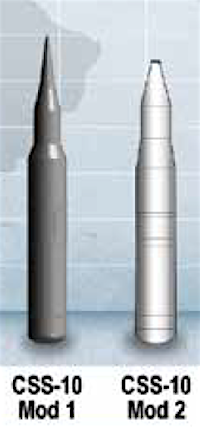 Deployment of the new generation of road-mobile ICBMs known as DF-31 and DF-31A ICBMs appears to have stalled; the number of launchers listed in the new report is the same as in the 2013 report: 5-10 DF-31s and “more than 15” DF-31As.
Deployment of the new generation of road-mobile ICBMs known as DF-31 and DF-31A ICBMs appears to have stalled; the number of launchers listed in the new report is the same as in the 2013 report: 5-10 DF-31s and “more than 15” DF-31As.
Yet the description of the DF-31A program sounds like deployment is still in progress: “The longer range CSS-10 Mod 2 will allow targeting of most of the continental United States” (emphasis added).
For the first time, the report includes a graphic illustration of the DF-31 and DF-31A side by side, which shows the longer-range DF-31A to be little shorter but with a less pointy nosecone and a wider third stage (see image).
The long-awaited (and somewhat mysterious) DF-41 ICBM is still not deployed. NASIC says the DF-41 is “possibly capable of carrying MIRV,” a less certain determination than the 2017 DOD report, which called the missile “MIRV capable.” The report lists the DF-41 with three stages and a Post-Boost Vehicle, details not provided in the previous report.
One of the two nuclear versions of the DF-21 MRBM appears to have been retired. NASIC only lists one: CSS-5 Mod 2. In total, the report lists “fewer than 50” launchers for the nuclear version of the DF-21, which is the same number it listed in the 2013 report (see here for description of one of the DF-21 launch units. But that was also the number listed back then for the older nuclear DF-21 (CSS-5 Mod 1). The nuclear MRBM force has probably not been cut in half over the past four years, so perhaps the previous estimate of fewer than 50 launchers was intended to include both versions. The NASIC report does not mention the CSS-5 Mod 6 that was mentioned in the DOD’s annual report from 2016.
Sea-Based Ballistic Missiles: The report lists a total of 48 JL-2 SLBM launchers, corresponding to the number of launch tubes on the four Jin-class (Type 094) SSBNs based at the Longpo Naval Base on Hainan Island. That does not necessarily mean, however, that the missiles are therefore fully operational or deployed on the submarines under normal circumstances. They might, but it is yet unclear how China operates its SSBN fleet (for a description of the SSBN fleet, see here).
The 2017 report no longer lists the Xia-class (Type 092) SSBN or the JL-1 SLBM, indicating that China’s first (and not very successful) sea-based nuclear capability has been retired from service.
Cruise Missiles: The new report removes the “conventional or nuclear” designation from the DH-10 (CJ-10) ground-launched land-attack cruise missile. The possible nuclear option for the DH-10 was listed in the previous three NASIC reports (2006, 2009, and 2013). The DH-10 brigades are organized under the PLA Rocket Force that operates both nuclear and conventional missiles.
A US Air Force Global Strike Command document in 2013 listed another cruise missile, the air-launched DH-20 (CJ-20), with a nuclear option. NASIC has never attributed nuclear capability to that weapon and the Office of the Secretary of Defense stated recently that the Chinese Air Force “does not currently have a nuclear mission.”
At the same time, the Director of the Defense Intelligence Agency (DIA) recently told Congress that China was upgrading is cruise missiles further, including “with two, new air-launched ballistic [cruise] missiles, one of which may include a nuclear payload.”
Pakistan
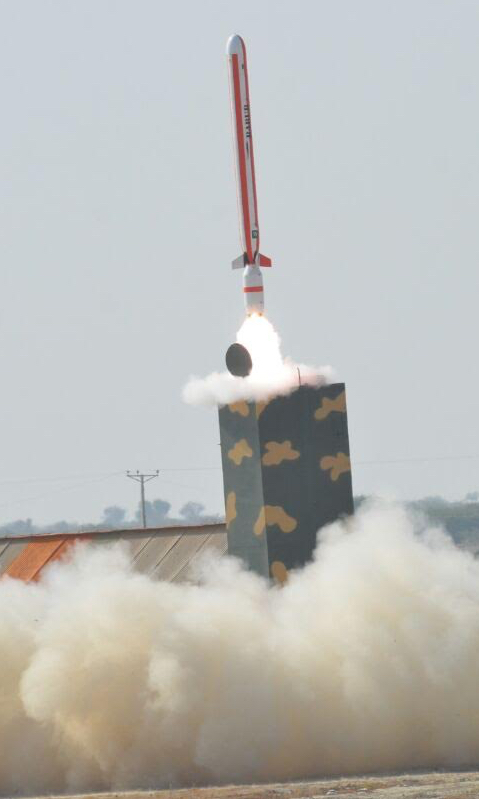
The NASIC report surprisingly does not list Pakistan’s Babur GLCM as operational.
The NASIC report states that “Pakistan continues to improve the readiness and capabilities of its Army Strategic Force Command and individual strategic missile groups through training exercises that include live missile firings.” While all nuclear-armed states do that, the implication probably is that Pakistan is increasing the reaction time of its nuclear missiles, particularly the short-range weapons.
The report states that the Shaheen-2 MRBM has been test-launched “seven times since 2004.” While that fits the public record, NASIC doesn’t mention that the Shaheen-2 for some reason has not been test launched since 2014, which potentially could indicate technical problems.
The Abdali SRBM now has a range of 200 km (up from 180 km in the 2013 report). It is now designated as close-range ballistic missile instead of a short-range ballistic missile.
NASIC describes the Ababeel MRBM, which was first test-launch in January 2017, as as “MIRVed” missile. Although this echoes the announcement made by the Pakistani military at the time, the designation “the MIRVed Abadeel” sounds very confident given the limited flight history and the technological challenges associated with developing reliable MIRV systems.
Neither the Ra’ad ALCM nor the Babur GLCM is listed as deployed, which is surprising especially for the Babur after 13 flight tests. Babur launchers have been fitting out at the National Development Complex for years and are visible at some army garrisons. Nor does NASIC mention the Babur-2 or Babur-3 (naval version) versions that have been test-flown and announced by the Pakistani military.
India
It is a surprise that the NASIC report only lists “fewer than 10” Agni-2 MRBM launchers. This is the same number as in 2013, which indicates there is still only one operational missile group equipped with the Agni-2 seven years after the Indian government first declared it deployed. The slow introduction might indicate technical problems, or that India is instead focused on fielding the longer-range Agni-3 IRBM that NASIC says is now deployed with “fewer than 10” launchers.
Neither the Agni-4 nor Agni-5 IRBMs are listed as deployed, even though the Indian government says the Agni-4 has been “inducted” into the armed forces and has reported three army “user trial” test launches. NASIC says India is developing the Agni-6 ICBM with a range of 6,000 km (3,728 miles).
For India’s emerging SSBN fleet, the NASIC report lists the short-range K-15 SLBM as deployed, which is a surprise given that the Arihant SSBN is not yet considered fully operational. The submarine has been undergoing sea-trials for several years and was rumored to have conducted its first submerged K-15 test launch in November 2016. But a few more are probably needed before the missile can be considered operational. The K-4 SLBM is in development and NASIC sets the range at 3,500 km (2,175 miles).
As for cruise missiles, it is helpful that the report continue to list the Bramos as conventional, which might help discredit rumors about nuclear capability.
North Korea
Finally, of the nuclear-armed states, NASIC provides interesting information about North Korea’s missile programs. None of the North Korean ICBMs are listed as deployed.
The report states there are now “fewer than 50” launchers for the Hwasong-10 (Musudan) IRBM. NASIC sets the range at 3,000+ km (1,864 miles) instead of the 4,000 km (2,485 miles) sometimes seen in the public debate.
Likewise, while many public sources set the range of the mobile ICBMs (KN-08 and KN-14) as 8,000 km (4,970 miles) – some even longer, sufficient to reach parts of the United States, the NASIC report lists a more modest range estimate of 5,500+ km (3,418 miles), the lower end of the ICBM range.
Additional Information:
- Full NASIC report: Ballistic and Cruise Missile Threat 2017 [Note: A corrected NASIC report was published in June 2017.]
- Previous versions of this NASIC report: 2006, 2009, 2013
- Status of World Nuclear Forces
This publication was made possible by a grant from the Carnegie Corporation of New York, the New Land Foundation, and the Ploughshares Fund. The statements made and views expressed are solely the responsibility of the author.
US-China Scientific Cooperation “Mutually Beneficial”
The US and China have successfully carried out a wide range of cooperative science and technology projects in recent years, the State Department told Congress last year in a newly released report.
Joint programs between government agencies on topics ranging from pest control to elephant conservation to clean energy evidently worked to the benefit of both countries.
“Science and technology engagement with the United States continues to be highly valued by the Chinese government,” the report said.
At the same time, “Cooperative activities also accelerated scientific progress in the United States and provided significant direct benefit to a range of U.S. technical agencies.”
The 2016 biennial report to Congress, released last week under the Freedom of Information Act, describes programs that were ongoing in 2014-2015.
See Implementation of Agreement between the United States and China on Science and Technology, report to Congress, US Department of State, April 2016.
The Pentagon’s 2017 Report On Chinese Military Affairs
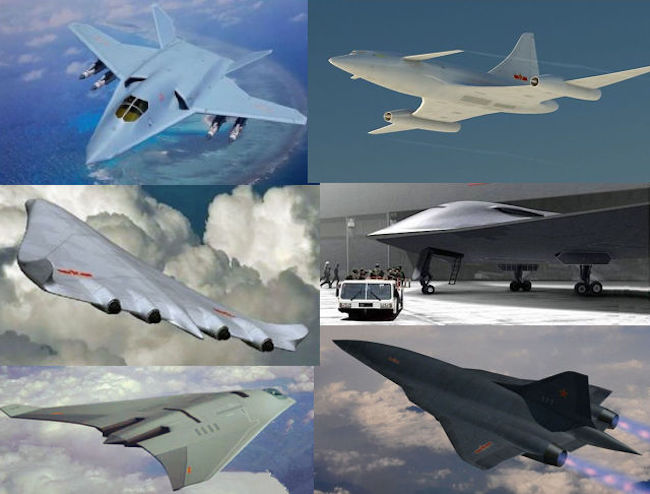
The Pentagon report says China is “developing a strategic bomber that officials expect to have a nuclear mission.” The Internet is full of artistic fantasies of what it might look like.
By Hans M. Kristensen
The Pentagon’s latest annual report to Congress on Chinese military and security developments describes a nuclear force that is similar to previous years but with a couple of important new developments in the pipeline.
The most sensational nuclear news in the report is the conclusion that China is developing a new strategic nuclear bomber to replace the aging (but upgraded) H-6.
The report also portrays the Chinese ICBM force as a little bigger than it really is because the report lists missiles rather than launchers. But once adjusted for that, the report shows the same overall nuclear missile force as in 2016, with two new land-based missiles under development (DF-26 and DF-41) but not yet operational.
The SSBN force is described as the same four boats but with “others” under construction. The report is a bit hasty to declare China now has a survivable sea-based deterrent, a condition that will require a few more steps.
Finally, the report concludes that Chinese nuclear strategy and doctrine, despite a domestic debate about scope and role, are unchanged from previous years.
Nuclear Bombers?
The Pentagon report states unequivocally that the Chinese Air Force “does not currently have a nuclear mission.” Yet bombers delivered nuclear gravity bombs in at least 12 of China’s nuclear test explosions between 1965 and 1979, so China probably has some dormant air-delivered nuclear capability.
But the report goes further by stating that China now “is developing a strategic bomber that officials expect to have a nuclear mission.”
In making this affirmative conclusion, the report refers to several sources. First, a 2016 statement by PLAAF commander Ma Xiaotian that China was “developing a next generation, long-range strike bomber” to replace the H-6 bombers. Second, the “nuclear” role is attributed to unidentified “observers” and speculations that “past PLA writings” about the need for a “stealth strategic bomber” suggests “aspirations to field a strategic bomber with a nuclear delivery capability.“
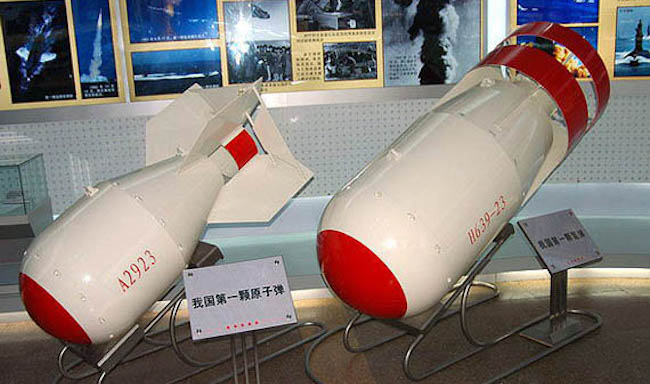
Although the Pentagon report says the Chinese Air Force does not currently have a nuclear mission, China has developed and tested nuclear gravity bombs. Mock-ups of the first fission bomb (left) and first thermonuclear bomb are on display in Beijing.
A U.S. Air Force Global Strike Command briefing in 2013 attributed nuclear capability to the CJ-20 air-launched cruise missile that is now operational with the H-6K bomber. And in May 2017, the U.S. Defense Intelligence Agency told Congress that China is “upgrading its aircraft…with two, new air-launched [ballistic cruise] missiles, one of which may include a nuclear payload.”
Whether a nuclear strategic bomber emerges sometime in the mid-2020s remains to be seen. If so, it would change China’s nuclear posture into a formal Triad of air-, land- and sea-based nuclear capabilities, similar to U.S. and Russian strategic arsenals.
The ICBM Force
The most mysterious nuclear number in the Pentagon report is this: “75-100 ICBMs.”
According to the report, “China’s nuclear arsenal currently consists of approximately 75-100 ICBMs, including the silo-based CSS-4 Mod 2 (DF-5A) and Mod 3(DF-5B); the solid-fueled, road-mobile CSS-10 Mod 1 and Mod 2 (DF-31 and DF-31A); and the more-limited-range CSS-3 (DF-4).”
The “75-100 ICBMs” estimate was also made in the 2016 report, but in the 2015 and earlier reports, the estimate was: “China’s ICBM arsenal currently consists of 50-60 ICBMs” of the same five types. For the “75-100 ICBM” estimate to be true, China would have had to add 15-40 ICBMs between 2015 and 2016, which probably did not happen.
The confusion appears to be caused by a change in terminology: the “75-100” is the number of missiles available for the ICBM launchers, some of which have reloads. There are only 50-75 ICBM launchers, the same number listed in the previous six reports. In fact, the ICBM force structure appears to have been relatively stable since 2011.

The 2017 report lists the same number of Chinese ICBM launchers as the previous six years. Click on image to view full size.
Of those 50-75 ICBM launchers, only about 45 (DF-5 and DF-31A) can target the continental United States.
Development continues of the road-mobile DF-41 ICBM, which the report says is “MIRV capable” like the existing silo-based DF-5B. The rumored DF-5C that some news media reported earlier this year is not mentioned in the Pentagon report, even though the Chinese Ministry of Defense appeared to acknowledge the existence of a DF-5C version in a response to the rumors.
Other Land-Base Nuclear Missiles
The report states that China in 2016 began fielding the new road-mobile, dual-capable, intermediate-range DF-26. The missile is not included in the total missile force overview, however, indicating that it is not yet operational. The maximum range is estimated at 4,000 km (2,485 miles), which means it could potentially target Guam from eastern China (similar to the current DF-4 and DF-31).
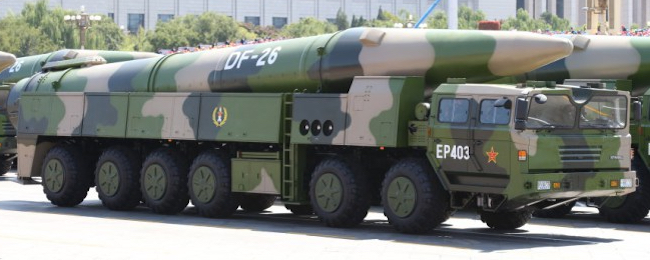
The DF-26 IRBM is “fielding” but the Pentagon report does not yet include it in the total missile count.
The road-mobile DF-26 will complement the existing force of DF-21 medium-range missiles, of which two versions are nuclear-capable, in China’s regional deterrence mission. And the DF-26 will probably replace the old liquid-fueled DF-4. The other old liquid-fueled missile, the DF-3A, now appears to have been retired.
The SSBN Force
The Pentagon report lists four Jin-class (Type-024) SSBNs as commissioned and “others under construction.” All Jin SSBNs are homeported at the Longpo Naval Base on Hainan Island. The report declares that “China’s JIN SSBNs, which are equipped to carry up to 12 CSS-N-14 (JL-2) SLBMs, are the country survivable sea-based nuclear deterrent.”
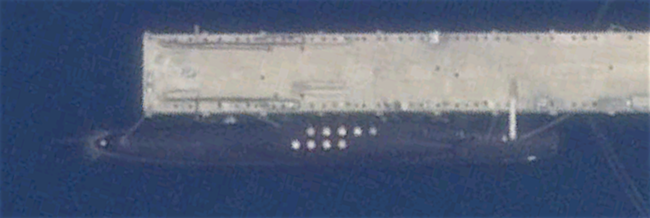
One of the four Jin-class SSBNs based at Longpo Naval Base on Hainan Island flashes nine of twelve SLBM tubes. Image: DigitalGlobe via GoogleEarth, April 17, 2016.
There are probably several caveats buried in that assessment. First, “survivable” requires that the SSBNs, once deployed at sea, can hide and avoid detection by US and allied anti-submarine warfare capabilities. Jin SSBNs apparently are rather noisy. Second, is the JL-2 operational on the SSBNs? Do they deploy with the missiles, train with them, and do they practice deterrent patrols and launch procedures?
The operational status is unclear from the report, which instead describes an effort to develop “more sophisticated C2 systems and processes” for “future SSBN deterrence patrols…” Rather, the Jin SSBNs appear to be a work in progress.
One indication the Jin-class might not constitute a “survivable” capability is that development of a replacement has already started. The future SSBN, which the Pentagon report says might begin construction in the early-2020s, reportedly will be equipped with a new SLBM known as JL-3. The new missile will probably have longer range than the current JL-2, which is insufficient to target the continental United Stated from Chinese waters.
Once China develops an operational aircraft carrier battle group, the report predicts, it would also be able to protect nuclear ballistic missile submarines stationed on Hainan Island. China has already built a carrier pier at the Yulin Naval Base on Hainan Island (see image below). Like so many other things, such a carrier battle group mission would depend on a number of things, not least how survivable it will be and how effective its anti-submarine capability will be.

The Liaoning docked at the carrier pier at Yulin Naval Base on Hainan Island. Image: DigitalGlobe via GoogleEarth, December 3, 2013.
Additional information:
- Pentagon Annual Report To Congress: Military and Security Developments Involving the People’s Republic of China 2017
- FAS Nuclear Notebook: Chinese Nuclear Forces 2016
- Status of World Nuclear Forces
This publication was made possible by a grant from the Carnegie Corporation of New York, the New Land Foundation, and the Ploughshares Fund. The statements made and views expressed are solely the responsibility of the author.
